Article of the Professor of institute of Slavic philology of the Polish academy of Sciences, the art critic and the literary critic - Grazhina Bobilevich "To history of eseninsky portraits: Sergey Yesenin in the image of the Ryazan artist Alexey Akindinov (experience of preliminary interpretation)".
It is published - the «Modern Eseninovedeniye» magazine. Ryazan. 2013 . No. 25. P. 3 - 18. (9 illustrations, including 7 color and two b/w photos).
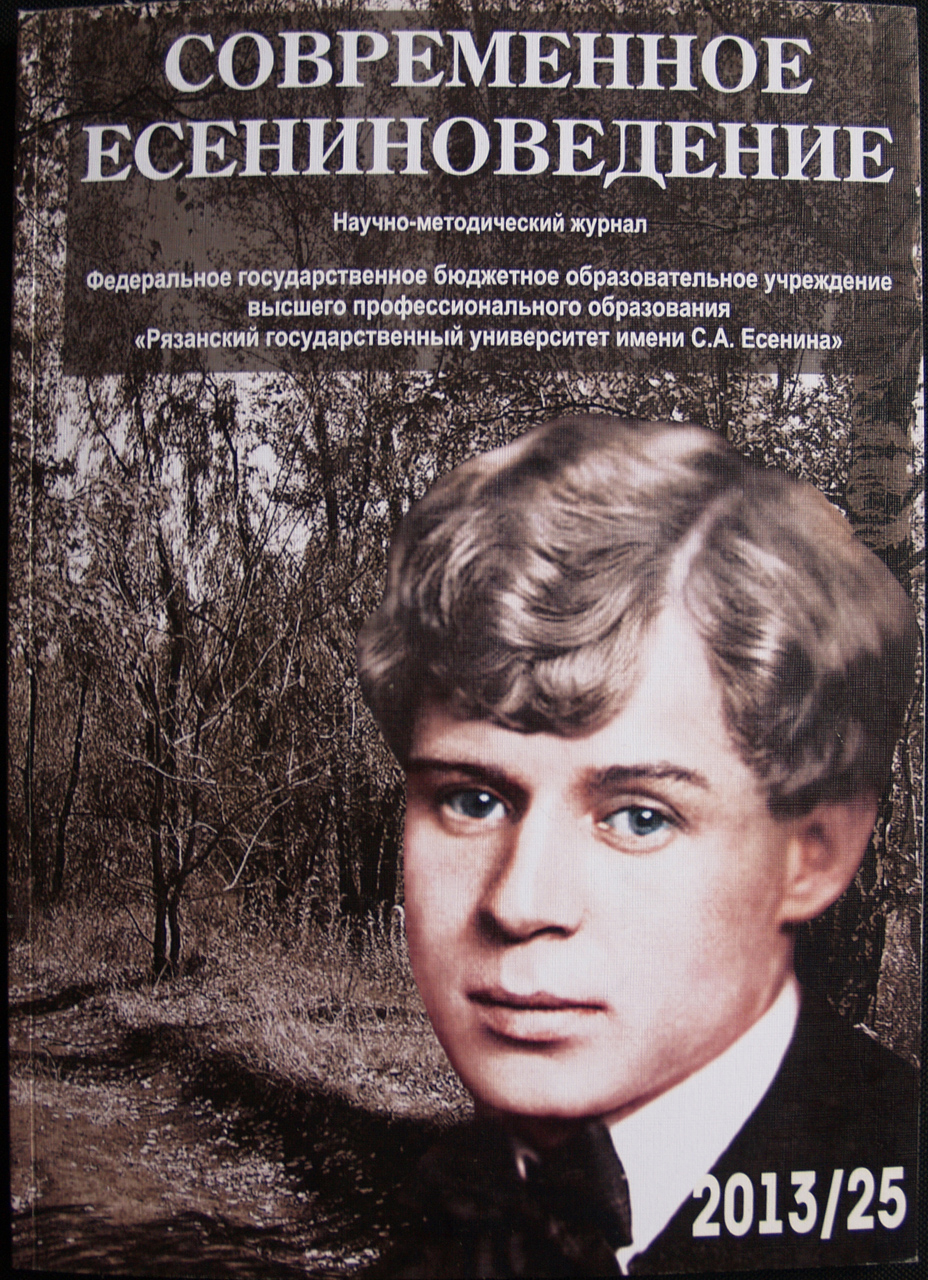
1st page of a cover of the «Modern Eseninovedeniye» magazine. No. 25. 2013 Ryazan.
On September 27, 2012, At Institute of the world literature of name A.M. Gorky the Russian Academy of Sciences, within the International scientific conference "Sergey Yesenin and Russian History" devoted to the 117th anniversary since the birth of S.A.Yesenin and Year of the Russian history, the Professor of Institute of Slavic philology of the Polish academy of Sciences, the art critic and the literary critic - Grazhina Bobilevich, read the report "To history of eseninsky portraits: Sergey Yesenin in Alexey Akindinov's image (experience of preliminary interpretation)".
The list of participants and a subject of reports on IMLI site of A.M. Gorky (Russian Academy of Sciences) (text in Russian)>>>
The archived version(text in Russian)>>>
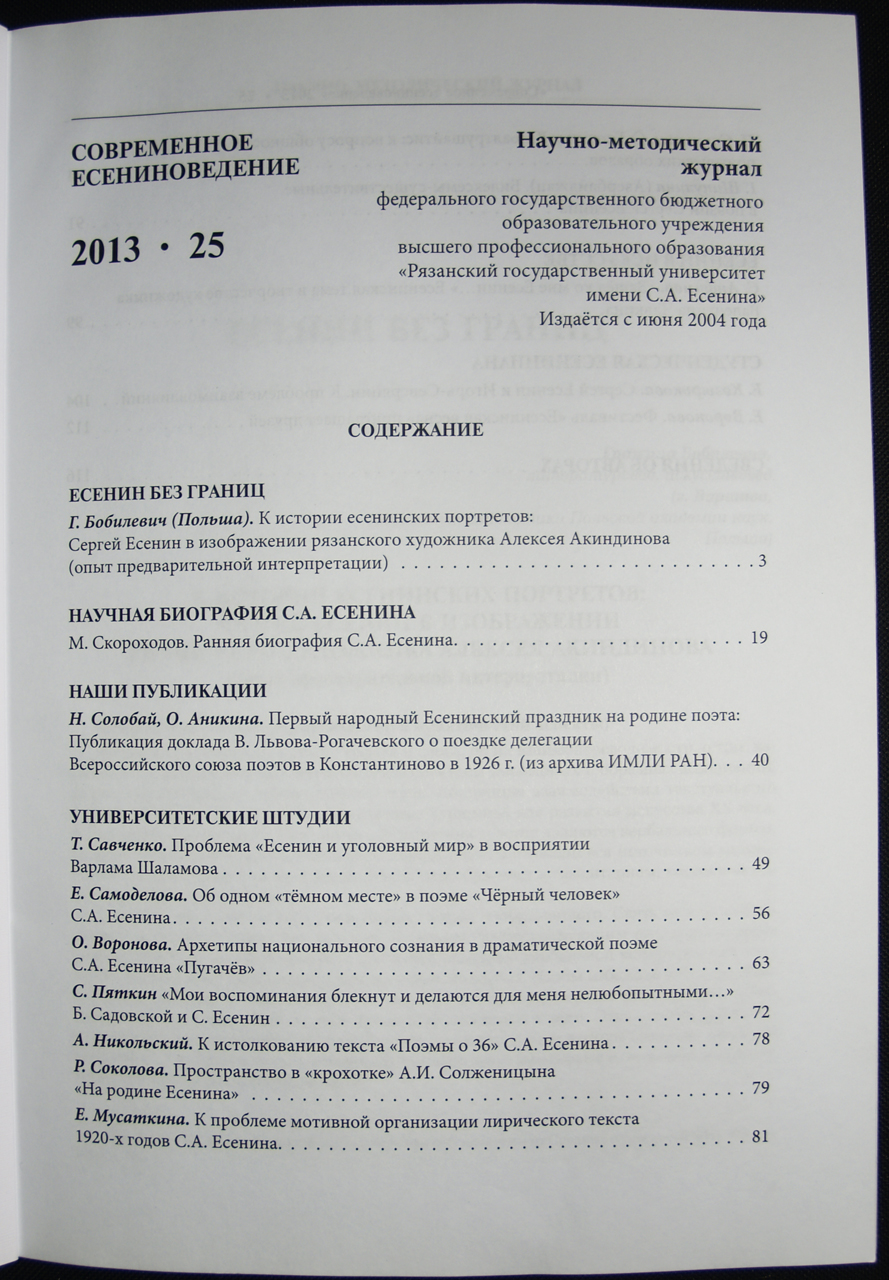
1st page of the «Modern Eseninovedeniye» magazine. No. 25. 2013 Ryazan. Contents of the magazine.
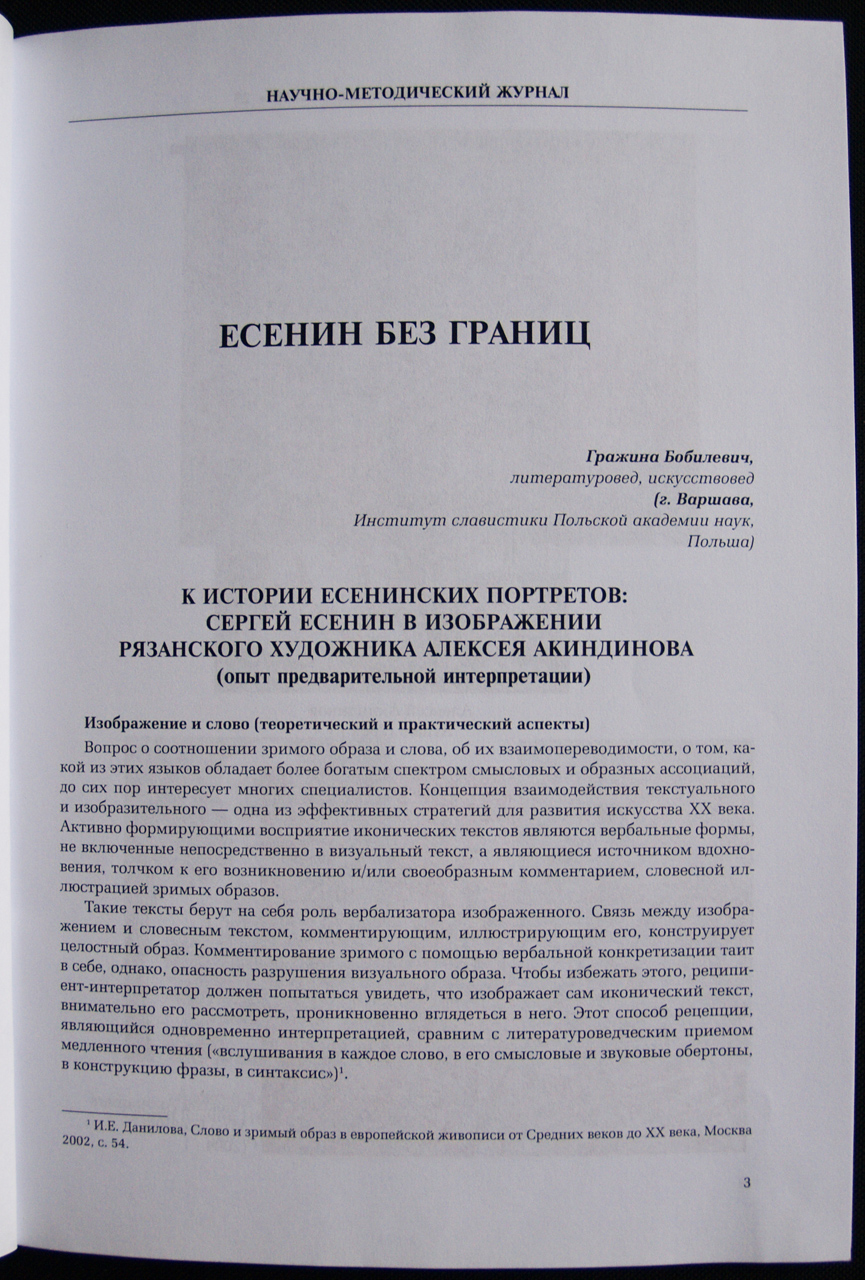
3rd page of the «Modern Eseninovedeniye» magazine. No. 25. 2013 Ryazan.
Heading "Yesenin without Borders".
Article of the Professor of Institute of Slavic philology of the Polish academy of Sciences (Warsaw), the art critic and the literary critic - Grazhina Bobilevich "To history of eseninsky portraits: Sergey Yesenin in the image of the Ryazan artist Alexey Akindinov (experience of preliminary interpretation)".
IMAGE AND WORD (theoretical and practical aspects).
The question of a ratio of a visible image and the word, about their mutually convertibility, about what of these languages possesses richer range of semantic and figurative associations, still interests many experts. The concept of interaction textual and graphic – one of effective strategy for development of art of the XX century. Perception of ikonichesky texts the verbal forms which haven't been included directly in the visual text, and being an inspiration source, a push to its emergence and/or a peculiar comment, a verbal illustration of visible images are actively forming. Such texts assume a role of a verbalizator represented. Communication between the image and the verbal text which is making comments, illustrating it, designs a complete image.
Commenting visible by means of a verbal specification conceals in itself, however, danger of destruction of a visual image. To avoid it the recipient interpreter has to try to see that represents the ikonichesky text, attentively to consider it, penetrating to peer into it. This way of reception being at the same time interpretation, we will compare to literary reception of slow reading ("attentive listening to every word, in its semantic and sound overtones, in a phrase design, in syntax") * (1).
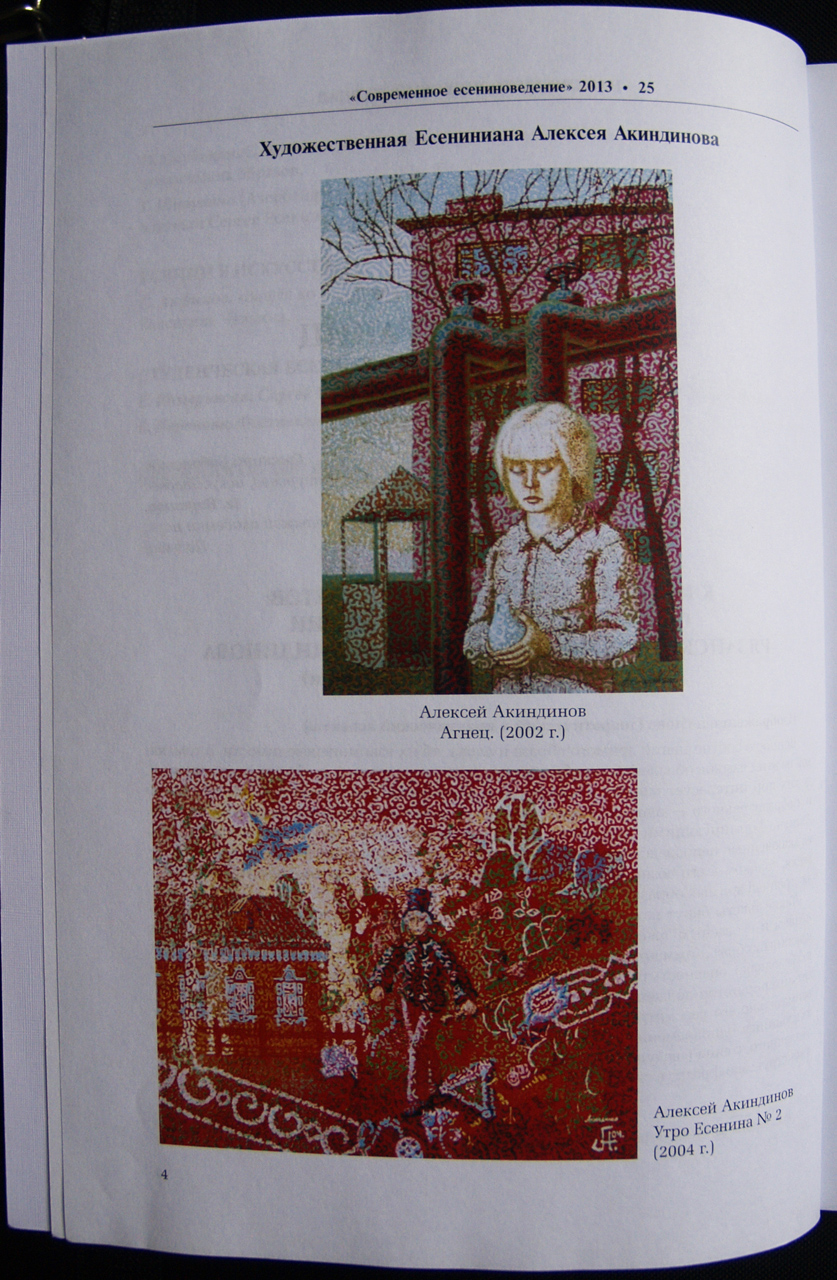
4th page of the magazine "Modern eseninovedenie." Number 25. 2013. Ryazan. Art Eseniniana of Alexey Akindinov. On top of the painting "The Lamb" (2002), at the bottom - the painting "Morning of Esenin, number 2" (2004)
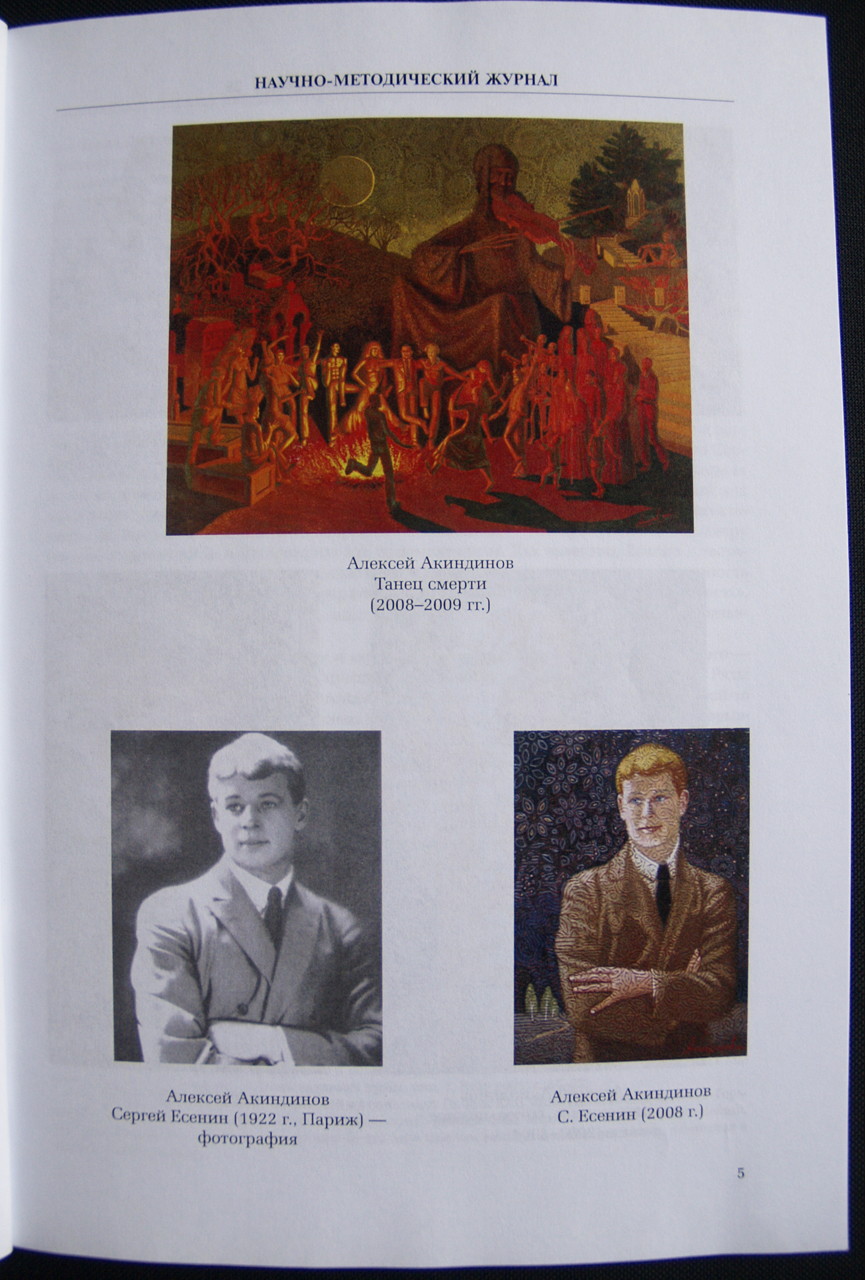
5th page of the «Modern Eseninovedeniye» magazine. No. 25. 2013 Ryazan. From above – the picture "Death Dance" (2008-2009gg. ) . Below: at the left – the photo "Sergey Yesenin" (1922 Paris), on the right – Alexey Akindinov's picture "S. Yesenin" (2008)
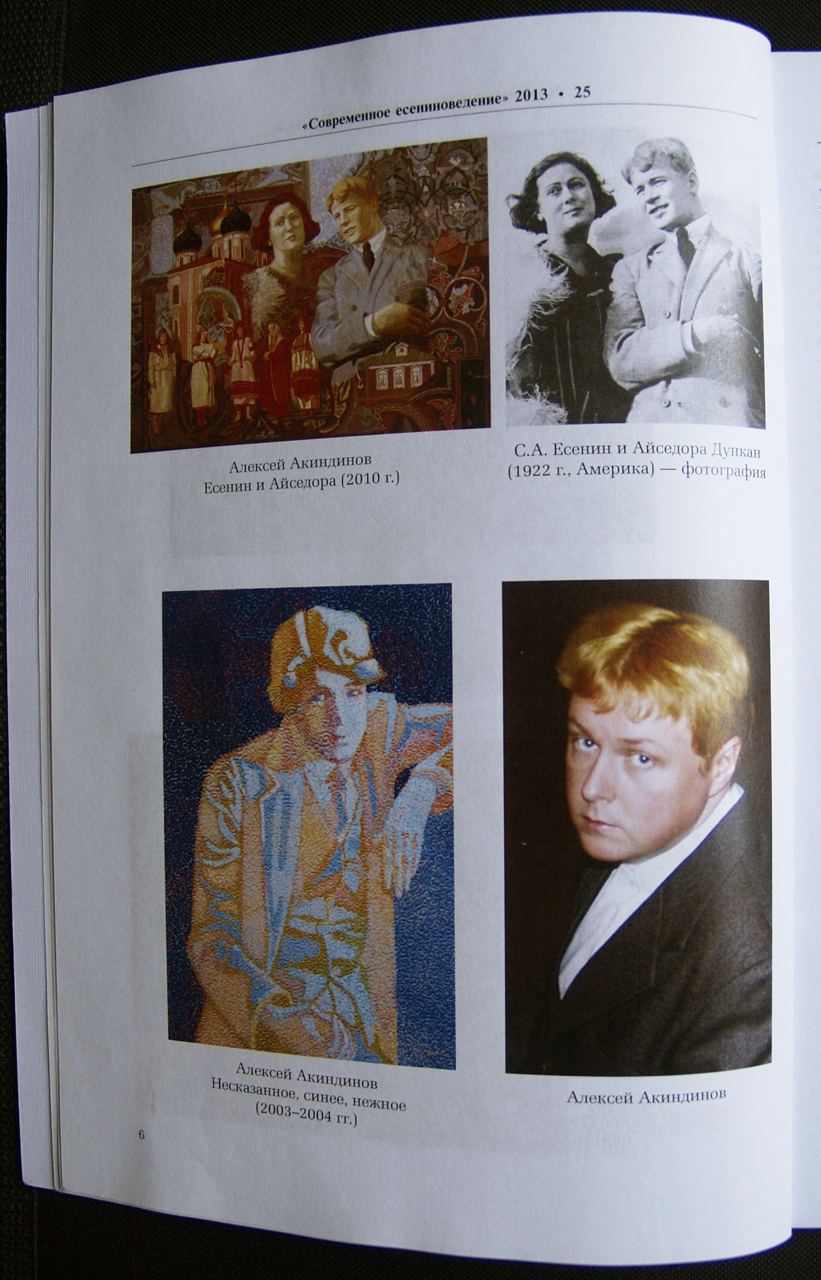
6th page of the «Modern Eseninovedeniye» magazine. No. 25. 2013 Ryazan. Top row: at the left – Alexey Akindinov's picture "Yesenin and Isadora "(2010). on the right – the photo "S.A.Yesenin and Isadora Duncan (1922, America). Bottom row: at the left – Alexey Akindinov's picture "Inexpressible, blue, gentle …", on the right – the photo "Alexey Akindinov" (2010)
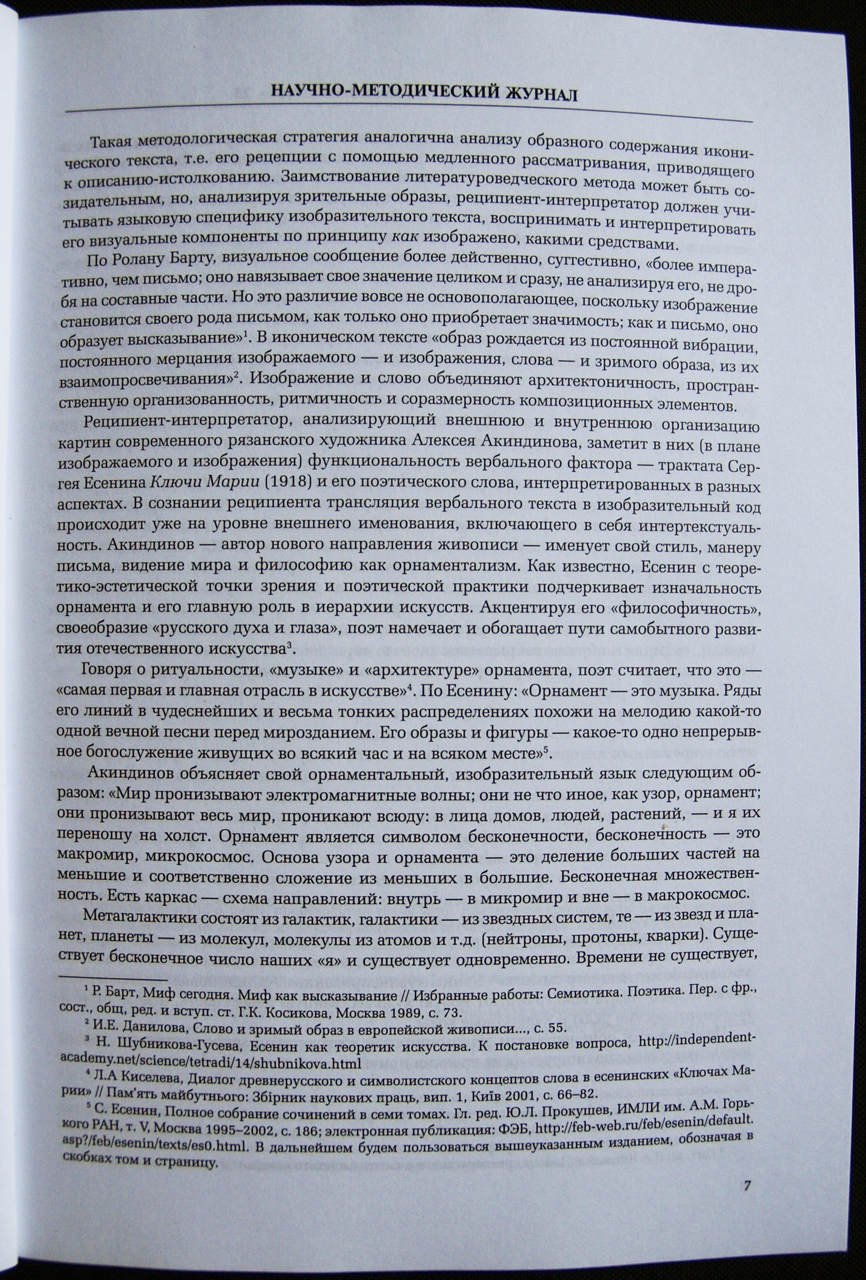
7th page of the «Modern Eseninovedeniye» magazine. No. 25. 2013 Ryazan.
Such methodological strategy is similar to the analysis of the figurative contents of the ikonichesky text, i.e. its reception by means of the slow examining leading to the description interpretation. Loan of a literary method can be creative, but, analyzing visions, the recipient interpreter has to consider language specifics of the graphic text, perceive and interpret its visual components by the principle as is represented, what means. According to Rolan Bart, the visual message is more effective, suggestivno, "more imperatively, than the letter; it imposes the value entirely and at once, without analyzing it, without splitting up for components. But this distinction not so fundamental as the image becomes some kind of letter as soon as it gains the importance; as well as the letter, it forms the statement" * (2). In the ikonichesky text "the image is born from continuous vibration, continuous blinking represented – and images, words – and a visible image, from their mutually raying" * (3). The image and the word unite an arkhitektonichnost, spatial organization, rhythm and harmony of composite elements.
The recipient interpreter analyzing the external and internal organization of pictures of modern, Ryazan artist Alexey Akindinov, will notice in them (in respect of represented and images) functionality of a verbal factor – Sergey Yesenin's treatise "Maria's Keys" (1918) and his poetic word, interpreted in different aspects. In consciousness of the recipient translation of the verbal text in a graphic code happens already at the level of the external imenovaniye including an intertekstualnost. Akindinov – the author of the new direction of painting, calls the style, a letter manner, vision of the world and philosophy as "ornamentalizm". It is known that Yesenin from the teoretiko-esthetic point of view and poetic practice emphasizes primordiality of an ornament and its leading role in hierarchy of arts.
Accenting its "philosophicity", an originality "the Russian mind and eyes", the poet plans and enriches ways of original development of domestic art * (4). Speaking about rituality, "music" and "architecture" of an ornament, the poet considers that it – "the very first and main branch in art" * (5). According to Yesenin: "The ornament is music. Ranks of its lines in the most wonderful and very thin distributions are similar to a melody of any one eternal song before a universe. Its images and figures – any one continuous church service living at any o'clock and on any place" * (6). Akindinov explains the ornamental, graphic language as follows: "The world is penetrated by electromagnetic waves; they no other than pattern, ornament; they penetrate the whole world, get everywhere: in faces of houses, people, plants, – and I transfer them to a canvas. The ornament is an infinity symbol, the infinity is a macrocosm, a microcosm. The basis of a pattern and ornament is a division of the most parts on smaller and respectively addition from smaller in big. Infinite plurality. There is a framework – the scheme of the directions: inside – in a microcosm and out of – in a macrocosmos. Metagalaxies consist of galaxies, a galaxy – of star systems, those is from stars and planets, a planet – from molecules, a molecule from atoms, etc. (neutrons, protons, quarks). There is an infinite number of ours "I" and exists at the same time. Time doesn't exist, only the consciousness moves a small droplet on infinite number of different opportunities.
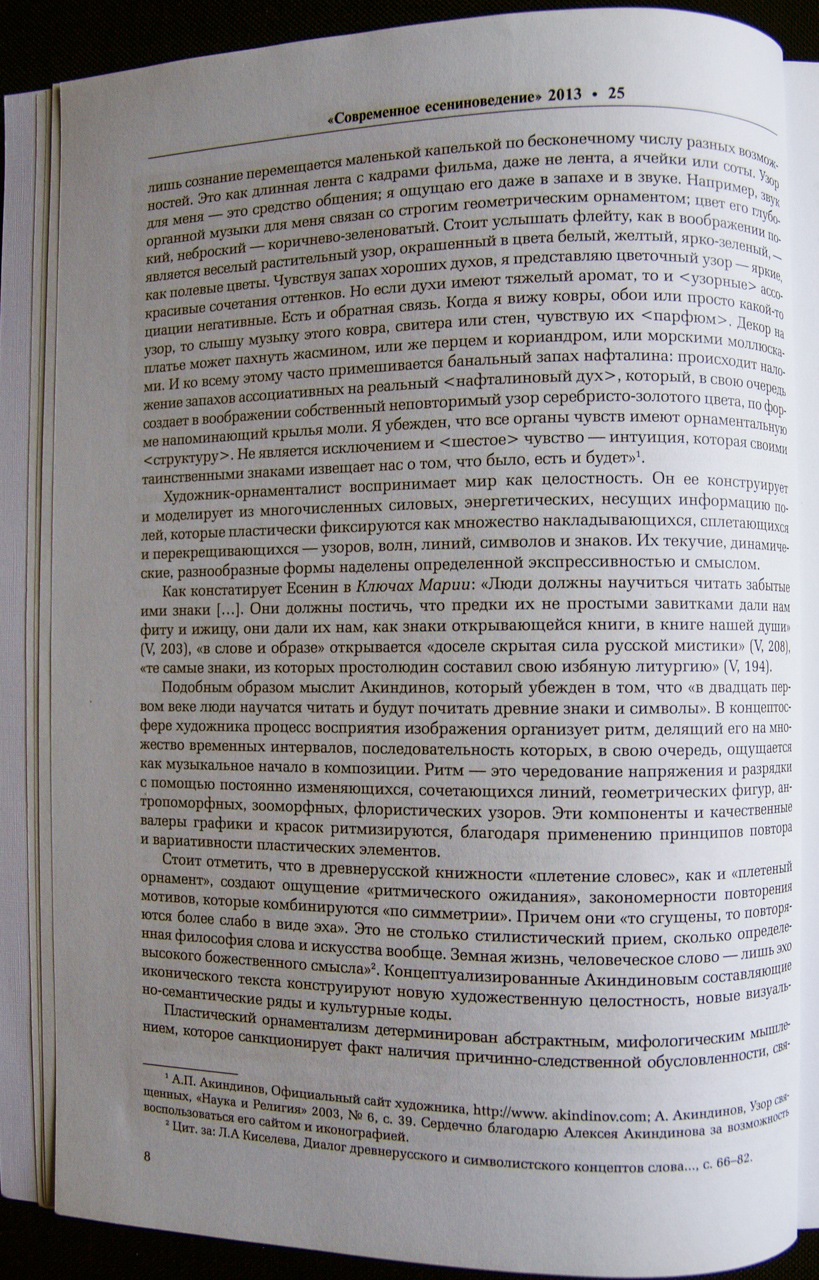
8th page of the «Modern Eseninovedeniye» magazine. No. 25. 2013 Ryazan.
It as a long tape with film frames, at all a tape, and cells or honeycombs. The pattern for me is a means of communication; I feel it even in a smell and in a sound. For example, the sound of an organ music for me is connected with a strict geometrical ornament; color its deep, not striking – brown-greenish. Once you hear a flute, in imagination there is the cheerful vegetable pattern painted in colors white, yellow, bright green, – as wild flowers. Catching a smell of good spirits, I represent a flower pattern – bright, beautiful combinations of shades. But if spirits have heavy aroma, and <patten> associations negative. There is also a feedback. When I see carpets, wall-paper or simply any pattern, I hear music of this carpet, a sweater or walls, I feel their <perfume>. The decor on a dress can smell as a jasmine, or pepper and a coriander, or sea mollusks. And to all this the banal smell of naphthalene is often added: there is an imposing of smells associative on real <naphthalenic spirit> which, in turn creates in imagination own unique pattern of silvery and gold color in a form reminding wings of a moth. I am convinced that all sense organs have ornamental <structure>. Isn't an exception and the <sixth> feeling – intuition which the mysterious signs informs us that was, is and will be" * (7).
The artist - an ornamentalist perceives the world as integrity. It designs it and models from numerous power, power fields bearing information which are plastically fixed as a set being imposed, being weaved and crossing – patterns, waves, lines, symbols and signs. Their fluid, dynamic, various forms are allocated with a certain expressivity and sense. As Yesenin in "Maria's Keys" states: "People have to learn to read the signs forgotten by them […]. They have to comprehend that ancestors not simple curls gave them to us фиту and an izhitsa, they gave them to us as signs of the opening book, in the book of our soul" (V, 203), "in the word and an image" the hidden power of the Russian mysticism" (V, 208), "those signs of which the commoner made the izbyany liturgy" (V, 194). Similarly thinks Akindinov , who is convinced that "in the twenty-first century, people learn to read , and will read the ancient signs and symbols ." In kontseptosfer process of the image of the artist organizes rhythm, dividing it into a plurality of time intervals , the sequence of which , in turn , feels like the beginning of a musical composition. Rhythm - is alternating tension and relaxation with the help of the ever-changing , mixing lines , geometric shapes , anthropomorphic , zoomorphic , floral patterns. These components and high-quality graphics and colors Valera ritmiziruyutsya through application of the principles of repetition and variation of plastic items. It is worth noting that in ancient literacy " weaving of words ," as well as " braided ornament ", creating a sense of " rhythmic expectations," repeating pattern motifs that combine " symmetry ". And they "that are condensed, repeat more poorly in the form of an echo". It not so much stylistic reception, how many certain philosophy of the word and art in general. Terrestrial life, the human word – only an echo of high divine sense" * (8). The components of the ikonichesky text conceptualized by Akindinov design the new art integrity, new visual and semantic ranks and cultural codes. The plastic ornamentalizm is determined by abstract, mythological thinking which authorizes the fact of existence of cause and effect conditionality, communications and interactions of the phenomena, unity unreal (in physical value) and real (in the sphere of emotions).
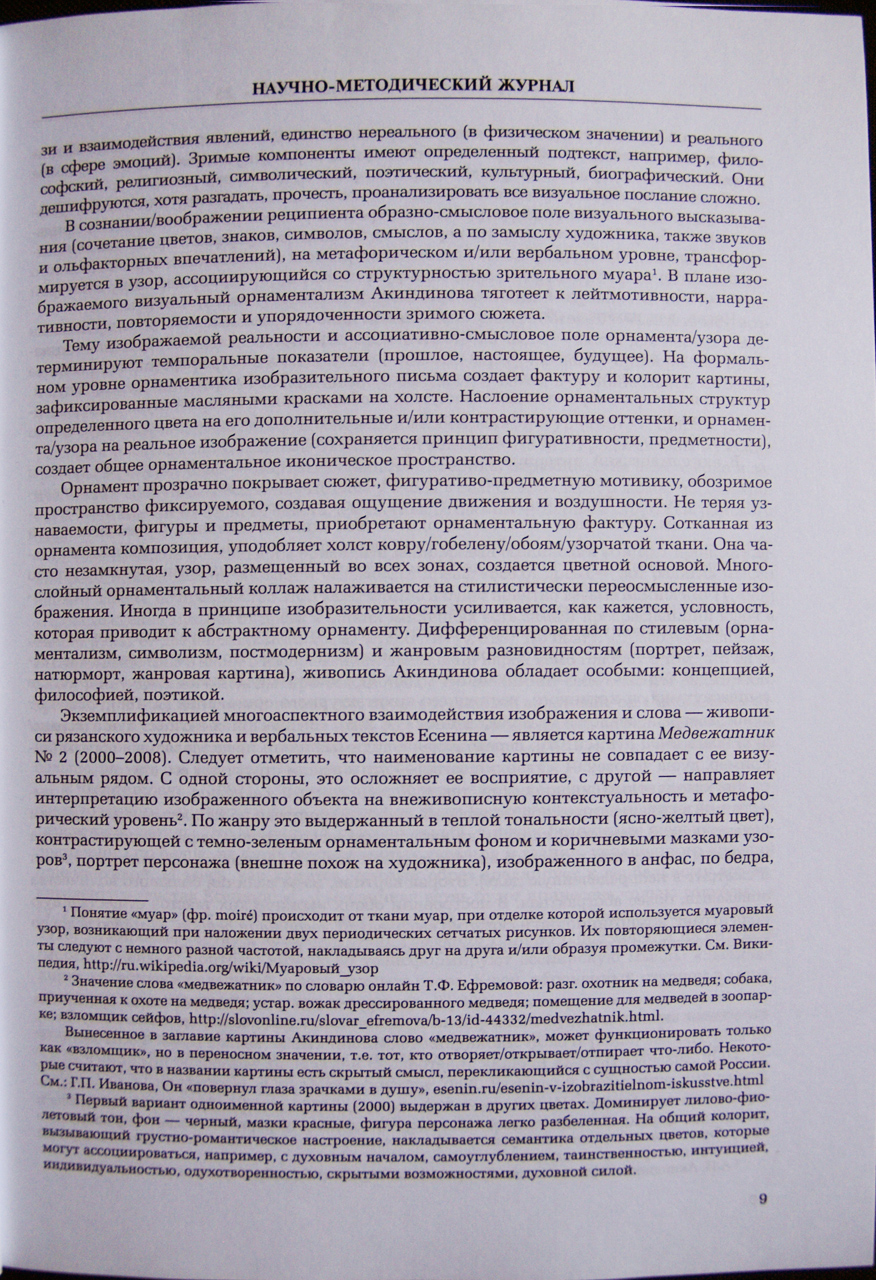
9th page of the Modern Eseninovedeniye magazine. No. 25. 2013 Ryazan.
Visible components have a certain implication, for example, philosophical, religious, symbolical, poetic, cultural, biographic. They will be decoded though to solve, read, analyse all visual message difficult. In consciousness/imagination of the recipient a figurative and semantic field of the visual statement (the combination of flowers, signs, symbols, meanings, and on a plan of the artist, also sounds and olfaktorny impressions), at metaphorical and/or verbal level, is transformed to a pattern associating with from a structural visual moiré * (9). In respect of Akindinov represented a visual ornamentalizm gravitates to the leitmotiv, a narrative, repeatability and orderliness of a visible plot. The subject of represented reality and associative and semantic field of an ornament/pattern are determined by temporal indicators (last, real, future). At formal level the twiddle of the graphic letter creates the invoice and the color of a picture recorded by oil paints on a canvas. Layering ornamental structures of a certain color to his additional and / or contrasting shades , and ornament / pattern on the actual image ( maintaining the principle of figurative art, objectivity ) , creates a common ornamental iconic space . Ornament transparent cover story, figurative , substantive motiviku , visible space fixed by creating a sense of movement and lightness . Wasting no recognition , shapes and objects acquire ornamental texture. Woven of ornament composition likens canvas carpet / tapestry / wallpaper / diaper . It is often not closed , pattern placed in all zones created colored base. Multi-layer laminated to the ornamental collage stylistically reinterpreted image. Sometimes , in principle, enhanced depiction seems to convention, which leads to an abstract ornament . Differentiated by stylistic ( ornamentalism , symbolism , postmodernism ) and genre species (portrait , landscape , still life , genre painting ), Akindinov's painting possesses the special: concept , philosophy and poetics .
Exemplification multifaceted interaction between the image and the words - Ryazan painting artist and verbal texts Esenina, a picture of the "Safecracker No. 2" ("Bear-hunter No. 2") (2000-2008).

"Safecracker number 2. (Bear-hunter)" 64x52sm., Oil on canvas. (2000 and 2008). Alexey Akindinov.
It should be noted that the name does not match the pattern of its visual side. On the one hand, it complicates the perception, on the other - directs the interpretation of objects is shown on vnezhivopisnuyu contextual and metaphorical level * (10). The genre is, designed in warm tones (clear yellow color), contrasting with the dark green and brown background ornamental patterns strokes * (11), a portrait of the character (looks like a painter), shown from the front, on the hip, with the key in right hand (depending on the part of the recipient.)
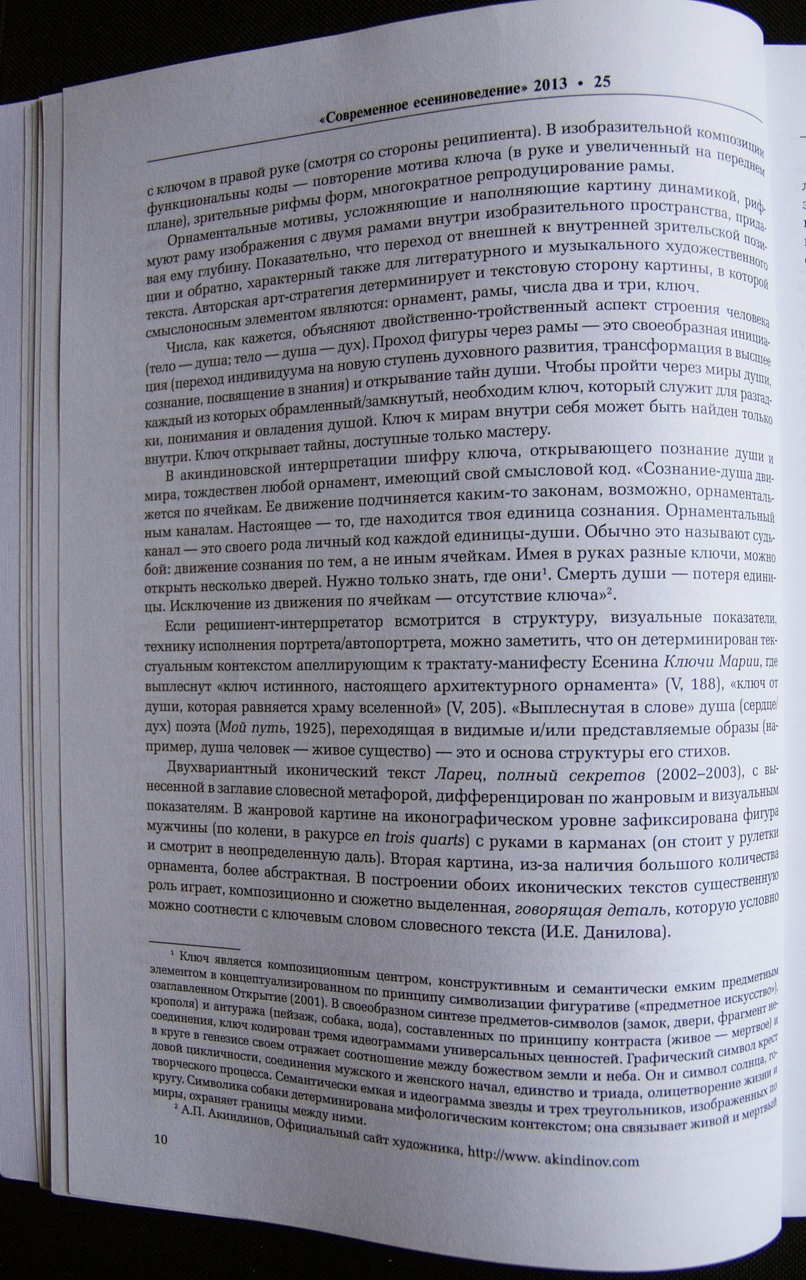
10th page of the magazine "Modern eseninovedenie." Number 25. 2013. Ryazan.
In the pictorial composition functional code - a key motif of repetition ( in the hand , and increased in the foreground ) , visual rhyme forms , multiple reproduction frame. Ornamental motifs , complicating the picture and filling dynamics, rhyme picture frame with two frames in visual space , giving it depth. It is significant that the transition from the outside to the inside of the viewing position , and vice versa, is also characteristic of the literary and musical art text . Author's art and text determines the strategy side of the picture , in which the element is smyslonosnym : ornament, frame number two and three, the key. The numbers seem to explain the dual - aspect of the triple structure of man (the body - the soul , the body - soul - spirit). The passage through the figure of the frame - a kind of initiation ( individual transition to a new stage of spiritual development , transformation into a higher consciousness , dedication to knowledge) and opening the secrets of the soul. To pass through the worlds of soul , each framed / closed , the right key , which is used for clues , understanding and mastering the soul. The key to the worlds within itself can only be found inside. Key reveals the secrets available only master. In akindinovskoy interpretation - the cipher key that opens the knowledge of the soul and the world, the identity of any ornament has a sense code. "Consciousness - soul moves into cells . Its movement is subject to any laws , possibly ornamental channels. Real - where is your consciousness unit . Ornamental canal - a kind of personal identification code of each unit - soul. This is usually referred to as destiny : the movement of consciousness on those and not other cells. Having in hand a different key , you can open a few doors . It is only necessary to know where they * (12). The death of the soul - the loss of unity. Exclusion of motion in cells - no key " * (13). If the recipient interpreter scrutinize the structure , visual indicators , performance techniques portrait / self-portrait to see that it is deterministic textual context appeals to the treatise , manifesto Esenina "Keys of Mary ", which splashed the "key true, real architectural ornament » (V, 188) , " the key to the soul, which is equal to the temple of the universe » (V, 205). " Throw out the word " soul (heart / spirit ) poet ( My Way , 1925) , passing in the visible and / or present the image (for example , the soul of man - the living entity ) - this is the basis of the structure of his poems.
Two-track iconic text "Larets(Box) full of secrets " (2002-2003), in the title of a verbal metaphor, differentiated by genre and visual indicators.

"Larets(Box) full of secrets №1." 114 х 117sm, oil on canvas. 2002 to 2003. Alexey Akindinov.
In genre painting at iconographic level the figure of the man (up to knees, in en trois quarts foreshortening) with hands in pockets (it costs at a roulette and looks in an uncertain distance) is recorded.

"Larets(Box) full of secrets №0." 114 х 117sm, oil on canvas. 2002 to 2003. Alexey Akindinov.
The second picture, because of the large number of ornaments, more abstract. In the construction of the two iconic texts plays an important role, composition and plot allocated, a talking piece, which can be roughly compared with the key word of the verbal text (I.E. Danilova).
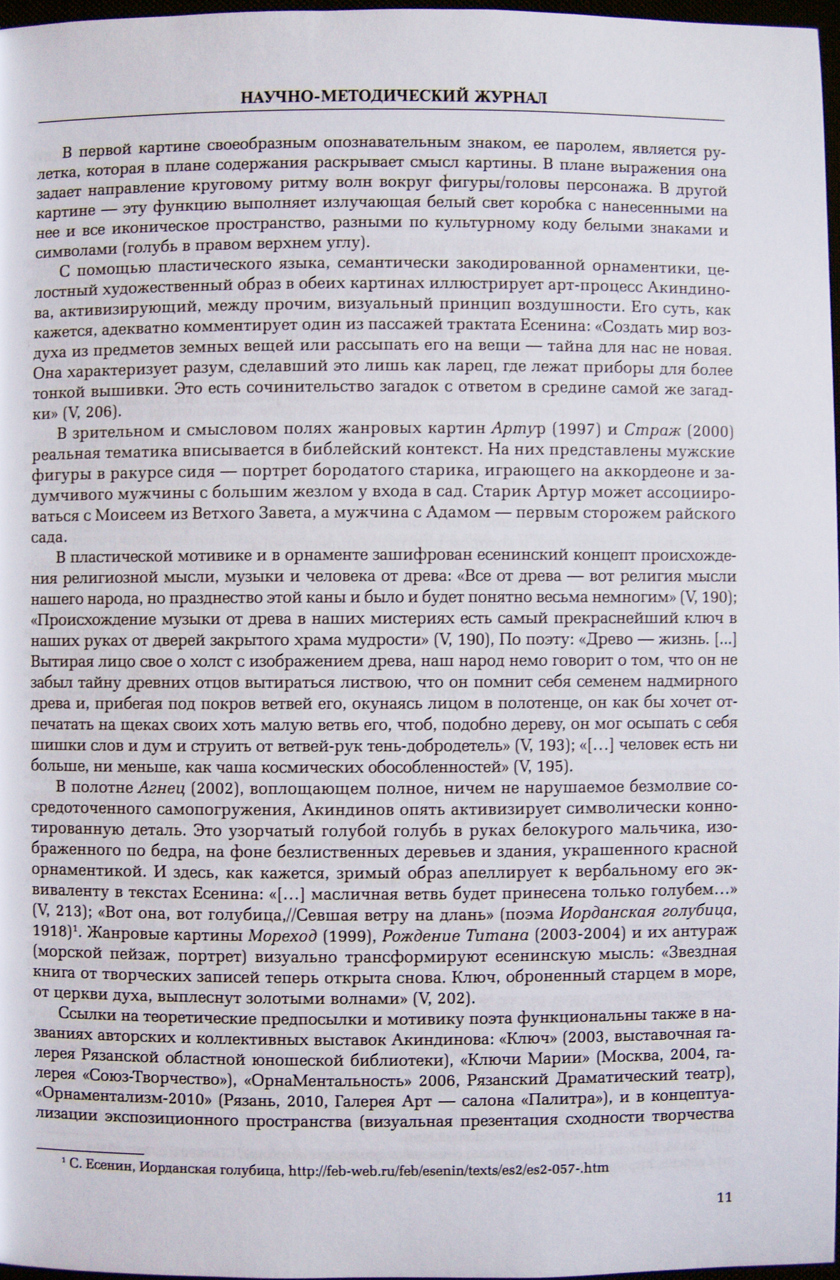
11th page of the magazine "Modern eseninovedenie." Number 25. 2013. Ryazan.
In the first picture a peculiar, identification mark, its password, the roulette which in respect of the contents opens sense of a picture is. In respect of expression it sets the direction to a circular rhythm of waves round the figure/the head of the character. In other picture – this function carries out, a box radiating this world, with put on it, and all ikonichesky space, white signs different in a cultural code and symbols (a pigeon in the right top corner). By means of the plastic language, semantic coded twiddle, the complete artistic image in both pictures illustrates Akindinov's which is making active, by the way, the visual principle of lightness the art process.
Its essence, apparently, adequately makes comments on one of passages of the treatise of Yesenin: "To create the air world from subjects of terrestrial things or to scatter it on a thing – secret for us not new. It characterizes the reason which has made it only as a larets where devices for thinner embroidery lie. It is writing of riddles with the answer in the middle of the riddle" (V, 206). In visual and semantic fields of conversations "Arthur" (1997) and "Warder" (2000) real subject fits into a bible context.

"Arthur". 50х40sm, canvas, oil. 1997. Alexey Akindinov.

"Warder". 60х50sm, canvas, oil. 2000. Alexey Akindinov.
On them man's figures in a foreshortening are presented sitting – a portrait of the bearded old man playing an accordion and the thoughtful man with a big staff at an entrance to a garden. Old man Arthur can associate with Moisey from the Old Testament, and the man with Adam – the first watchman of a paradise garden. In plastic мотивике and in an ornament the eseninsky concept of an origin of religious thought, music and the person from a tree is ciphered: "All from a tree – here religion of thought of our people, but festival of this Cana also was and it will be clear very few" (V, 190); "The music origin from a tree in our mysteries is the finest key in our hands from doors of the closed temple of wisdom" (V, 190). On the poet: "A tree – life. [...] Wiping the person about a canvas with the tree image, our people mutely say that he didn't forget secret of ancient fathers to be wiped by foliage that he remembers itself(himself) a seed of a nadmirny tree and, resorting under a cover of its branches, being dipped by the person into a towel, he as though wants to print on the cheeks though its small branch that, like a tree, he could shower from itself(himself) the cone of words and thoughts and струить from branches hands a shadow virtue" (V, 193); "[…] the person is neither more, nor it is less, as a bowl of space obosoblennost" (V, 195). In a cloth the "The Lamb" (2002), embodying full, nothing broken silence of the concentrated self-immersion, Akindinov again activates symbolically connote detail.

"The Lamb". 68x46, 2 cm, acrylic on canvas, oil. 2002. Alexey Akindinov.
It is patterned blue dove in the hands of a blond boy depicted on the hip, on the background of leafless trees and buildings are decorated with red ornaments . And here , it seems, the visible image appeals to its verbal equivalent in Yesenin's texts: "[... ] olive branch will be brought only dove ...» (V, 213 ), " That's it , that's a dove / / Grounded on the hand of the world " ( poem "The dove of Jordan ", 1918) * (14). Genre painting " Sailor " ( 1999), "The Birth of the Titan " ( 2003-2004 ) and their surroundings (sea landscape, portrait) Esenin visually transform the idea that : " Starry book of creative entries is now open again. The key is dropped by an old man in the sea, from the church of the spirit, splashed with gold waves »(V, 202).

"Seaman". 64хh91sm, canvas, oil. 1999. Alexey Akindinov.

"The birth of Titan." 105x210sm, oil on canvas. 2003. Alexey Akindinov.
Links to theoretical preconditions and motives of the poet are functional also in names of author's and collective exhibitions of Akindinov: "Key" (2003, exhibition gallery of the Ryazan regional junior library), "Maria's Keys" (Moscow 2004, «Creativity - Union» gallery), "Ornamentalnost" 2006, the Ryazan Drama theater), "Ornamentalizm-2010" (Ryazan 2010, Gallery the Art – Palitra salon), and in conceptualization of exposition space (visual presentation of similarity of creativity of the master of the word and the master of a brush, disclosure of an embodiment of soul in Yesenin's texts and in Akindinov's painting). As it seems, the Ryazan artist and on appearance tries to assimilate to the poet that is noticeable in his photos.
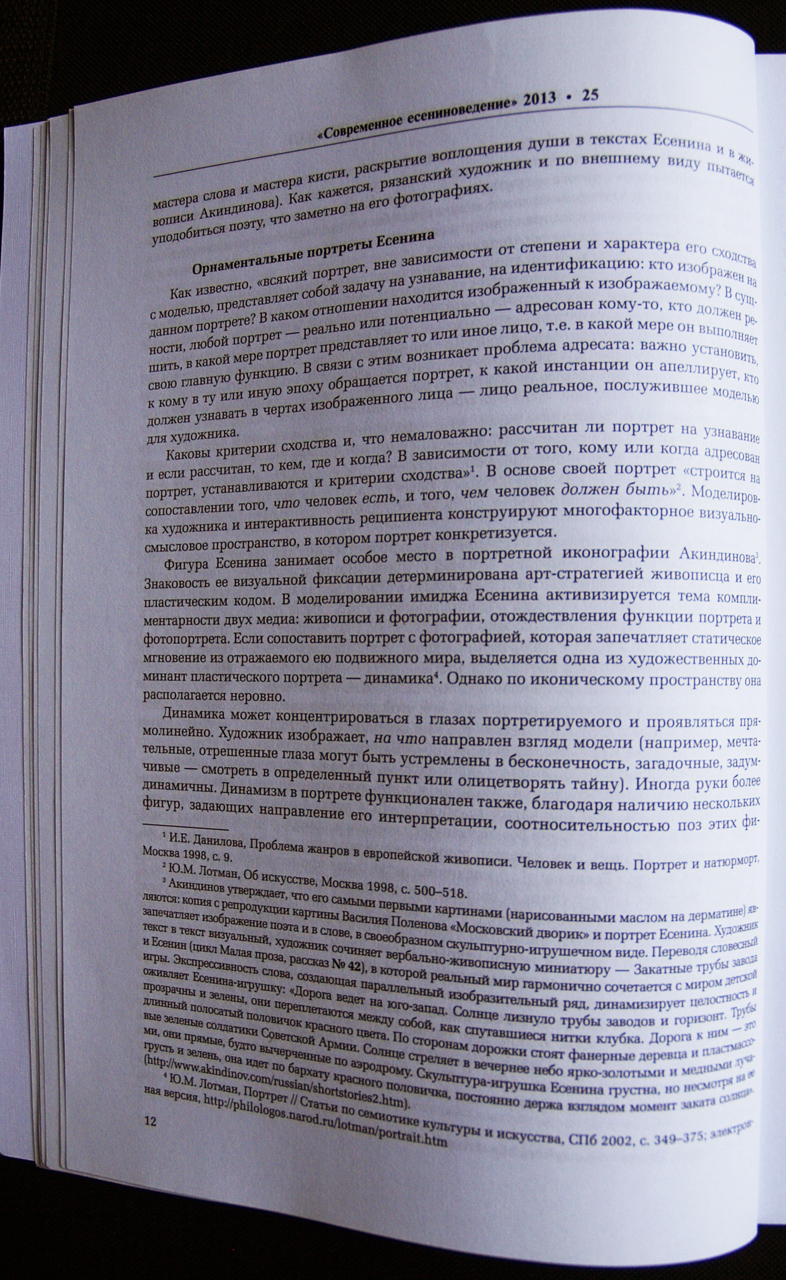
12th page of the «Modern Eseninovedeniye» magazine. No. 25. 2013 Ryazan. "Yesenin's ornamental portraits".
YESENIN'S ORNAMENTAL PORTRAITS.
It is known that "any portrait, regardless of degree and nature of its similarity to model, represents a task on recognition, on identification: who is represented on this portrait? In what relation is represented by represented. In effect, any portrait – really or potentially – is addressed to someone who has to solve, in what measure the portrait represents this or that person, i.e. in what measure it carries out the main function. In this regard there is a problem of the addressee: it is important to establish to whom during this or that era the portrait addresses, to what instance it appeals who has to learn in lines of the represented face – a face real, served as model for the artist. What are the criteria of similarity and, not least, is designed to portrait on the recognition and if calculated, by whom, where and when. Depending on who is addressed or when a portrait set and the criteria of similarity "* (15). At the heart of his portrait "based on a comparison of what a person is and what a person should be" * (16). The modeling of the artist and the interactivity of the recipient construct multifactorial visual semantic space in which concretize portrait.
Yesenin's figure takes a special place in Akindinov's portrait iconography * (17). Symbolical character of its visual fixing is determined by art strategy of the painter and his plastic code. In modeling of image of Yesenin the subject of a complementarity of two media becomes more active: painting and photo, identification of function of a portrait and photograph. If to compare a portrait with the photo which запечатляет the static instant from the mobile world reflected by it, is allocated one of art dominants of a plastic portrait – the loudspeaker * (18). However on ikonichesky space it settles down roughly. Dynamics can concentrate in the opinion of portretiruyemy and be shown rectilinearly. The artist represents, on what the model look (for example, the pensive, released eyes can be directed in infinity, mysterious, thoughtful to look in a certain point or to represent secret) is directed. Sometimes hands are more dynamic. Dynamism in a portrait is functional also, thanks to existence of several figures which are setting the direction to its interpretation, a sootnositelnost of poses of these figures, etc.
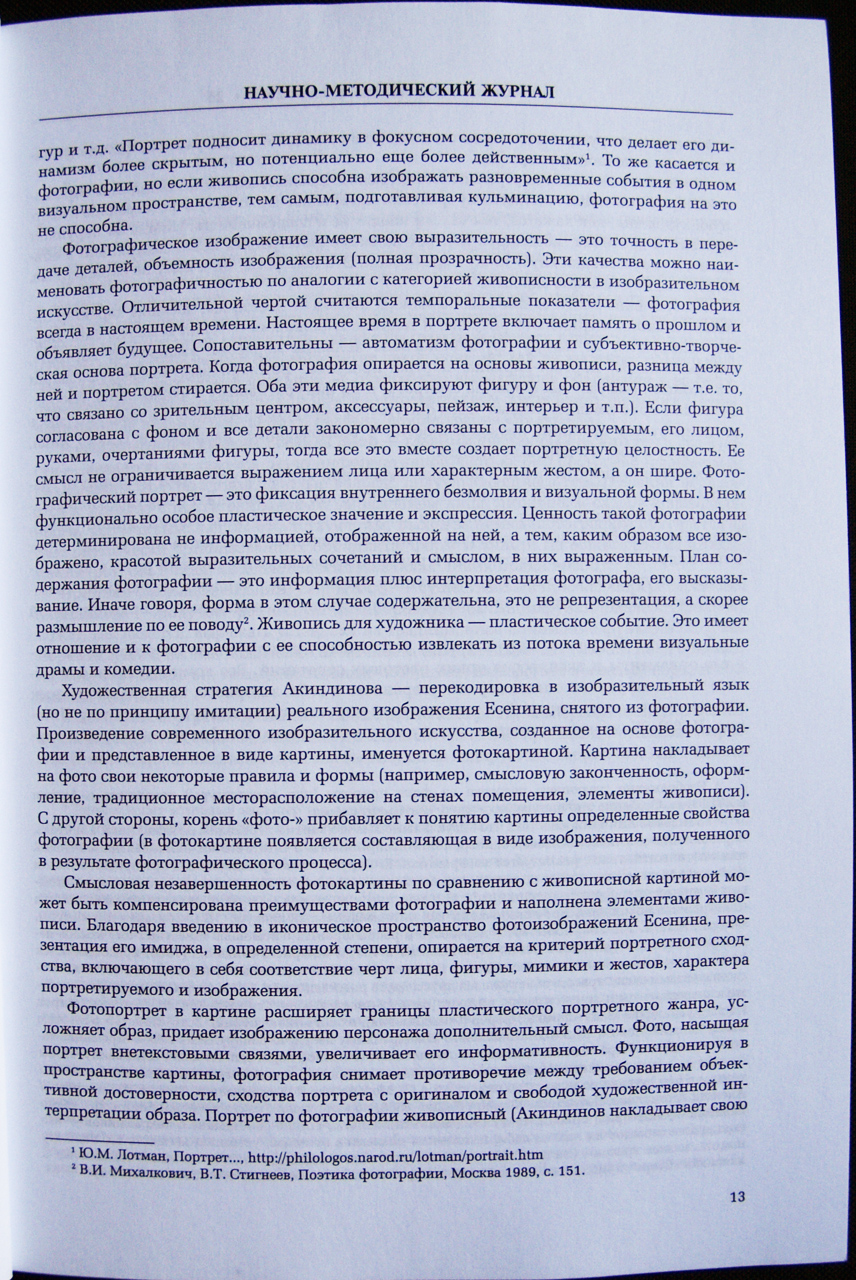
13th page of the magazine "Modern eseninovedenie." Number 25. 2013. Ryazan.
"Portrait brings the dynamics at the focal concentration, making it more dynamic hidden but potentially more effective " * (19). The same applies to photos, but if the painting can depict the diachronic developments in one visual space , thus preparing the culmination picture is not capable of . The photographic image has its expressiveness - is the accuracy in the transfer details, flatter image (full transparency ) . These qualities can name the photographic similar to the category of scenic beauty in art. A distinctive feature of the considered temporal indicators - photo always in the present tense . Currently, the portrait includes a memory of the past and announce future. Comparative - automatism photos and subjective- creative basis of the portrait. When the picture is based on the fundamentals of painting the difference between it and the portrait is erased. Both of these media are fixed figure and background ( surroundings - that is something that is associated with the visual center , accessories, landscape, interior , etc.). If the figure is consistent with the background and all the details associated with naturally portrayed , his face , hands , body shape , then all of this together creates a portrait integrity. Its meaning is not limited to face or the characteristic gesture , but it is wider . The photographic portrait - is fixing inner silence and visual form. It is functionally a special plastic meaning and expression . The value of such images is not deterministic information displayed on it, and the way in which all the shows , beauty and a sense of expressive combinations , they pronounced. Plan the content of photos - this information plus the interpretation of the photographer , his utterance . In other words , the form in this case is substantial , it is not representation, but rather on the subject of speculation * (20). Painting for the artist - a plastic event. This is related to photography , with its ability to extract from the flow of time visual drama and comedy.
Akindinov's art strategy – code conversion in graphic language (but not by the principle of imitation) Yesenin's real image removed from the photo. The work of the modern fine arts created on the basis of the photo and presented in the form of a picture, is called as a photopicture. The picture imposes on a photo the some rules and forms (for example, semantic completeness, the registration, a traditional site on room walls, painting elements). On the other hand, the root "a photo –" adds certain properties of the photo to concept of a picture (in a photopicture there is a component in the form of the image received as a result of photographic process). The semantic incompleteness photo pictures compared to the scenic picture may be offset by the benefits of the elements is filled with photos and paintings. With the introduction in the iconic space facsimiles Esenin’s presentation of its image , to a certain extent, based on the criterion of likeness , which includes compliance with the facial features , shapes, facial expressions and gestures, and the nature of the portrait image. Photographic portrait in the painting expands the plastic portrait genre , complicates the image , gives added meaning to the character image . Photo by saturating portrait of extra-textual links, increases its information content . Functioning in the space of the painting , photography removes the contradiction between the requirement of objective validity , the similarities with the original portrait and the freedom of artistic interpretation of the image . Portrait of a beautiful picture ( Akindinov puts his signature style of ornamental letters ) and at the same time supports the documentary photo of the original photo.
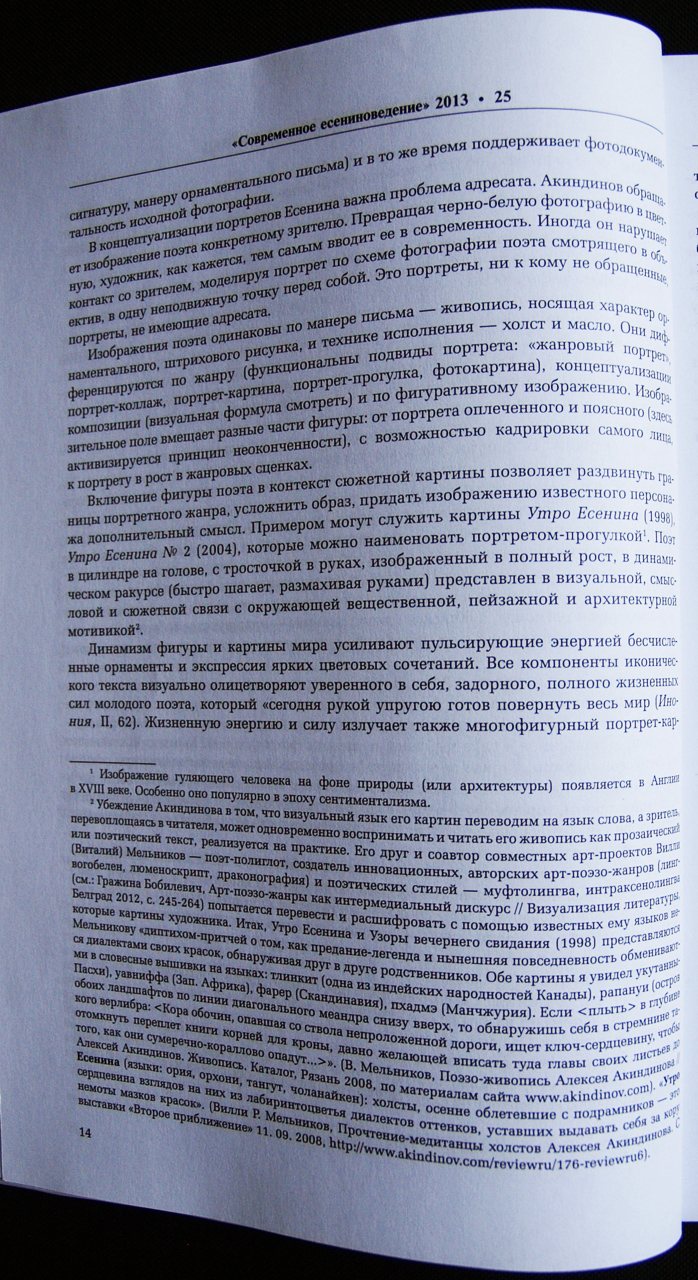
14th page of the «Modern Eseninovedeniye» magazine. No. 25. 2013 Ryazan.
In conceptualization of portraits of Yesenin the problem of the addressee is important. Akindinov turns the image of the poet to the specific viewer. Turning the black-and-white photo in color, the artist, apparently, thereby enters it into the present. Sometimes it breaks contact with the viewer, modeling a portrait according to the scheme of the photo of the poet looking in a lens, in one motionless point before itself. These are portraits, to anybody not turned, the portraits which don't have the addressee. Images of the poet are identical on a letter manner – the painting having character of ornamental, shaped drawing, and equipment of execution – a canvas and oil. They are differentiated on a genre (portrait subspecies are functional: "genre portrait", portrait collage, portrait picture, portrait walk, photopicture), composition conceptualizations (a visual formula to look) and according to the figurative image. The graphic field contains different parts of a figure: from a portrait "up to shoulders" and zone (the principle of not completion here becomes more active), with possibility of framing of the person, to a portrait in growth in genre sketches. Inclusion of a figure of the poet in a context of a subject picture allows to move apart borders of a portrait genre, to complicate an image, to give to the image of the known character additional sense. The pictures "Morning of Yesenin" (1998), "Morning of Yesenin No. 2" (2004) which can be nominated a portrait walk * (21) can be an example.

"Morning of Yesenin". 40х50sm, canvas, oil.1998. Alexey Akindinov.

"Morning of Yesenin №2". 40х50sm, canvas, oil. 2004. Alexey Akindinov.
The poet in the cylinder on the head, with a cane in the hands, represented to the utmost, in a dynamic foreshortening (quickly walks, swinging hands) is presented in visual, semantic and subject communication with surrounding material, landscape and architectural motiviky * (22). Dynamism of a figure and picture of the world is strengthened by uncountable ornaments pulsing by energy and an expression of bright color combinations. All components of the ikonichesky text visually represent assured in themselves, the fervent, young poet full of vital forces who "today a hand elastic is ready to turn the whole world" (Ioniya, II, 62). Vital energy and force radiates also multifigured portrait picture * (23) "Death dance" (2008-2009). Executed in symbolical and ornamental style, it is determined contextually * (24).

"Death dance". 105,3х130,3sm, canvas, oil. 2008 – 2009. Alexey Akindinov.
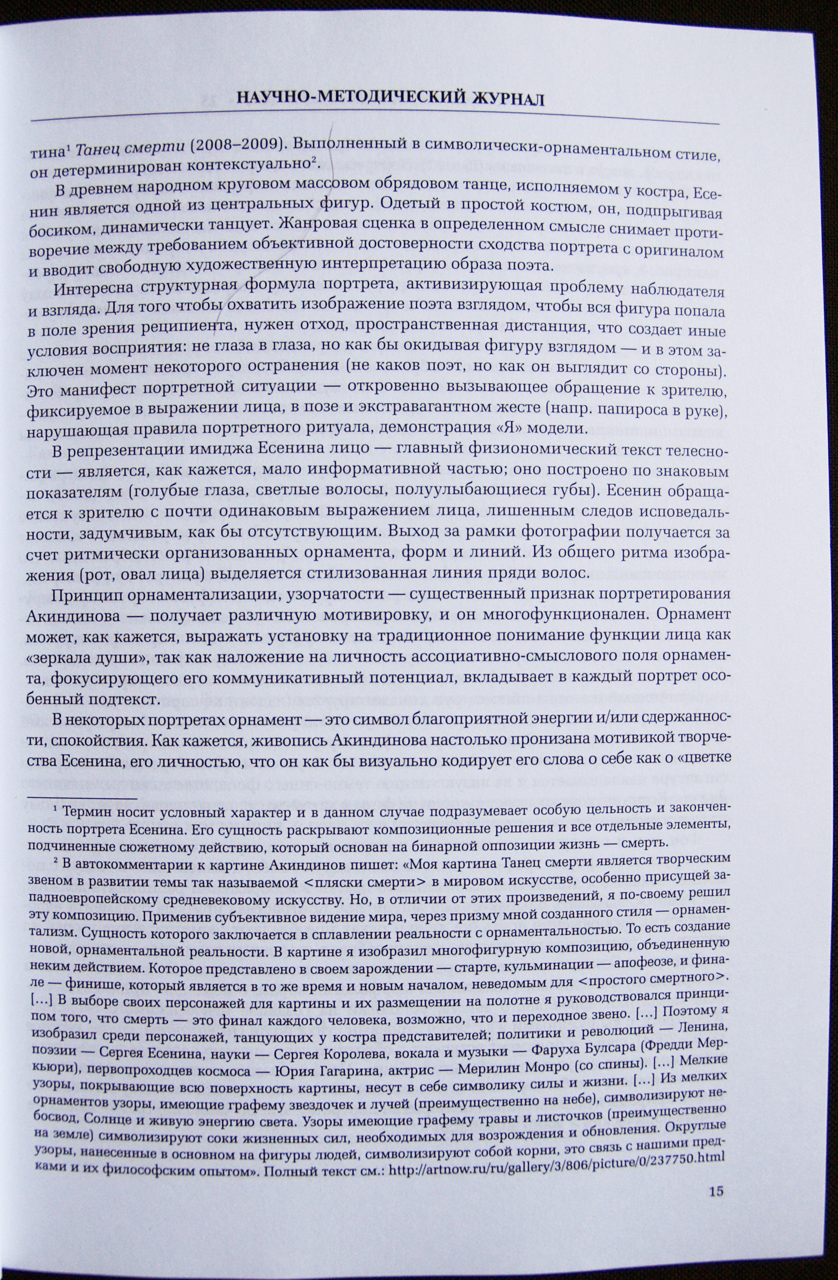
15th page of the «Modern Eseninovedeniye» magazine. No. 25. 2013. Ryazan.
In the ancient national circular mass, ceremonial dance executed at a fire, Yesenin is one of the central figures. Dressed in a simple suit, it, jumping up barefoot, dynamically dances. The genre sketch in a sense removes a contradiction between the requirement of objective reliability of similarity of a portrait with the original and enters free art interpretation of an image of the poet.
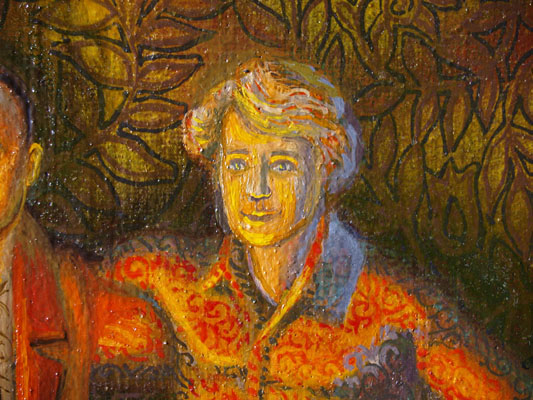
Sergey Yesenin. Picture "Death Dance" fragment.
The structural formula of a portrait which is making active a problem of the observer and a look is interesting. To capture the image of the poet a look that all figure came into the view of the recipient, withdrawal, a spatial distance that creates other conditions of perception is necessary: not eyes in eyes, but as though taking of a figure a view – and in it the moment of some distancing (not what poet but as it looks from outside) is concluded. It is the manifesto of a portrait situation – frankly defiant address to the viewer, fixed in a look, in a pose and extravagant gesture (e.g. a cigarette in a hand), breaking rules of portrait ritual, demonstration "I" models. In representation of image of Yesenin the person – the main physiognomical text of a corporality, is, apparently, a little informative part; it is constructed on sign indicators (blue eyes, a fair hair, a floor smiling lips). Yesenin addresses to the viewer with almost identical look deprived of traces of an ispovedalnost, thoughtful, to as though absent. The exit for a framework of the photo turns out at the expense of rhythmic organized an ornament, forms and lines. From the general rhythm of the image (the mouth, a face form) is allocated the stylized line of a lock of hair. The principle of an ornamentalization, the uzorchatost, essential sign of portraiture of Akindinov – receives various motivation and it multifunctional. The ornament can express, apparently, installation on traditional understanding of function of the person as "windows to the soul" as imposing on the identity of an associative and semantic field of the ornament focusing its communicative potential, puts special implication in each portrait. In some portraits the ornament is a symbol of favorable energy, and/or restraint, tranquillity. As it seems, Akindinov's painting is so penetrated motiviky Yesenin's creativity, his personality that it as though visually codes his words about as about "a flower unique" (I, 294), fixing and recovering the image of the poet through his words: "as cornflowers in a rye, blossom in the person of an eye" (II, page 87). Portraits of the poet speak: such is I is.
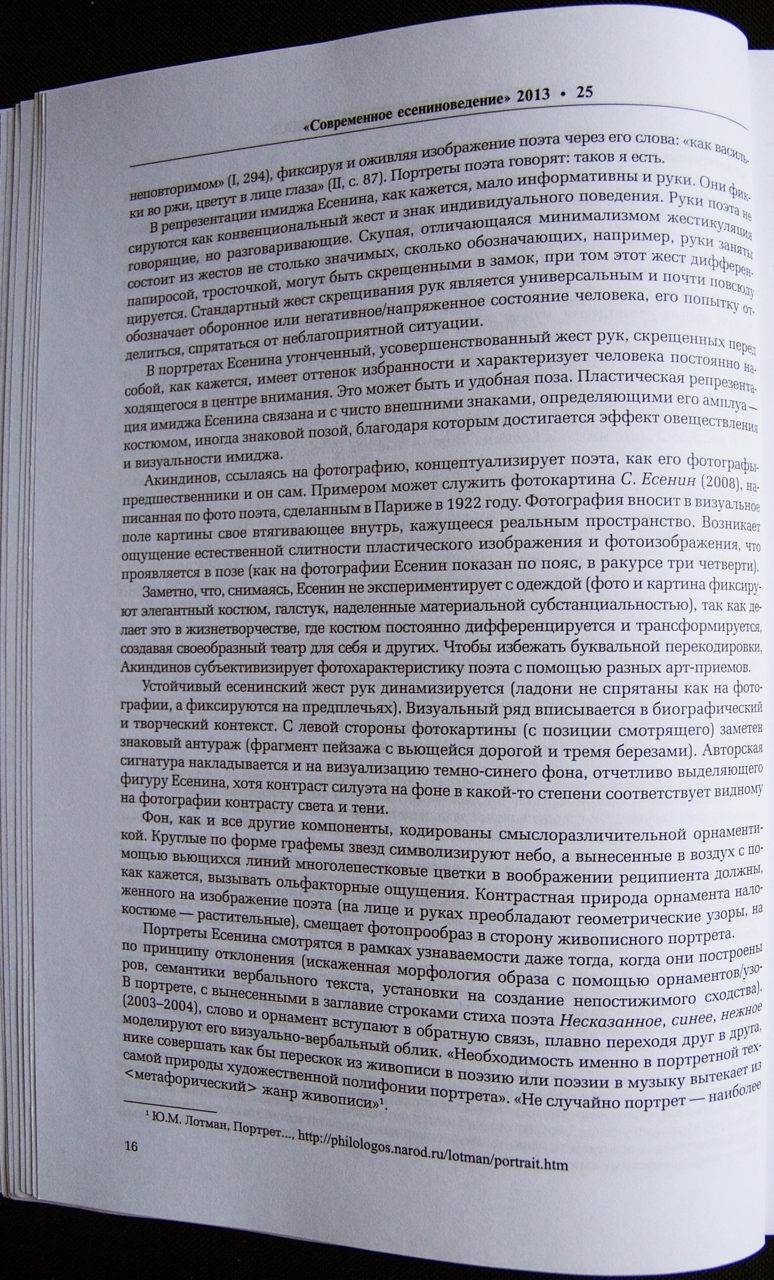
16th page of the «Modern Eseninovedeniye» magazine. No. 25. 2013 Ryazan.
In representation of image of Yesenin, apparently, hands are a little informative also. They are fixed as conventional gesture and a sign of individual behavior. Hands of the poet not speaking, but talking. Avaricious gesticulation differing by minimalism consists of gestures not so much significant, how many designating, for example, hands are occupied with a cigarette, a cane, can be crossed in the lock, thus this gesture is differentiated. Standard gesture of crossing of hands is universal and almost everywhere designates defensive or negative / a tension of the person, his attempt to separate, hide from an adverse situation. In Yesenin's portraits distinguished, advanced gesture of the hands crossed before, apparently, has a shade of a selectness and characterizes the person of attention constantly being in the center. It can be and a convenient pose. Plastic representation of image of Yesenin is connected and with purely external signs defining it by role – a suit, sometimes a sign pose thanks to which the effect of objectification and an image vizualnost is reached. Akindinov, referring to the photo, conceptualizes the poet as his photographers predecessors, and he. The photopicture "S. Yesenin" (2008) written on a photos of the poet, made in Paris in 1922 can be an example.

"Yesenin". 70х50sm, canvas, oil. 2008. Alexey Akindinov.
The photo brings in a visual field of a picture involving inside, seeming real space. There is a feeling of natural unity of the plastic image and the facsimile that is shown in a pose (as in the photo Yesenin is shown on a belt, in a foreshortening three quarters). It is noticeable that acting, Yesenin doesn't experiment clothes (the photo and a picture fix an elegant suit, a tie allocated with a material substantsialnost) as does it in a zhiznetvorchestvo where the suit is constantly differentiated and transformed, creating a peculiar theater for itself and others. To avoid literal code conversion, Akindinov shows the photo - the poet's description of using different art techniques. Yesenin steady hand gesture dynamized (palms aren't hidden as in the photo, and are fixed on forearms). A visual row fits into a biographic and creative context. On the left side of a photopicture (from a position looking) the sign surroundings (a landscape fragment with the curling road and three birches) is noticeable. The author's signature is imposed and on visualization of the dark blue background which is distinctly allocating a figure of Yesenin though contrast of a silhouette against to some extent corresponds to contrast of light and shade visible in the photo. The background, as well as all other components, are coded by a smyslorazlichitelny twiddle. Round in a form of a grapheme of stars symbolize the sky, and taken out in air by means of curling lines multipetal flowers, in imagination of the recipient have to cause olfaktorny feelings, apparently. The contrast nature of an ornament of the poet imposed on the image (on a face and hands geometrical patterns prevail, on a suit – vegetable) displaces a photoprototype towards a picturesque portrait.
Yesenin's portraits look within recognition even then when they are constructed by the principle of a deviation (the distorted morphology of an image by means of ornaments/patterns, semantics of the verbal text, installation on creation of incomprehensible similarity). In a portrait, with the lines of a verse of the poet taken out in the title "Inexpressible, blue, gentle" (2003-2004), the word and an ornament enter feedback, smoothly passing each other model its visual and verbal shape.

"Inexpressible, blue, gentle …" 66x44sm, canvas, oil. 2003-2004gg. Alexey Akindinov.
"Need for portrait equipment to make as though перескок from painting in poetry or poetry in music follows from the nature of art polyphony of a portrait". "Not casually a portrait – the most <metaphorical> genre of painting" * (25).
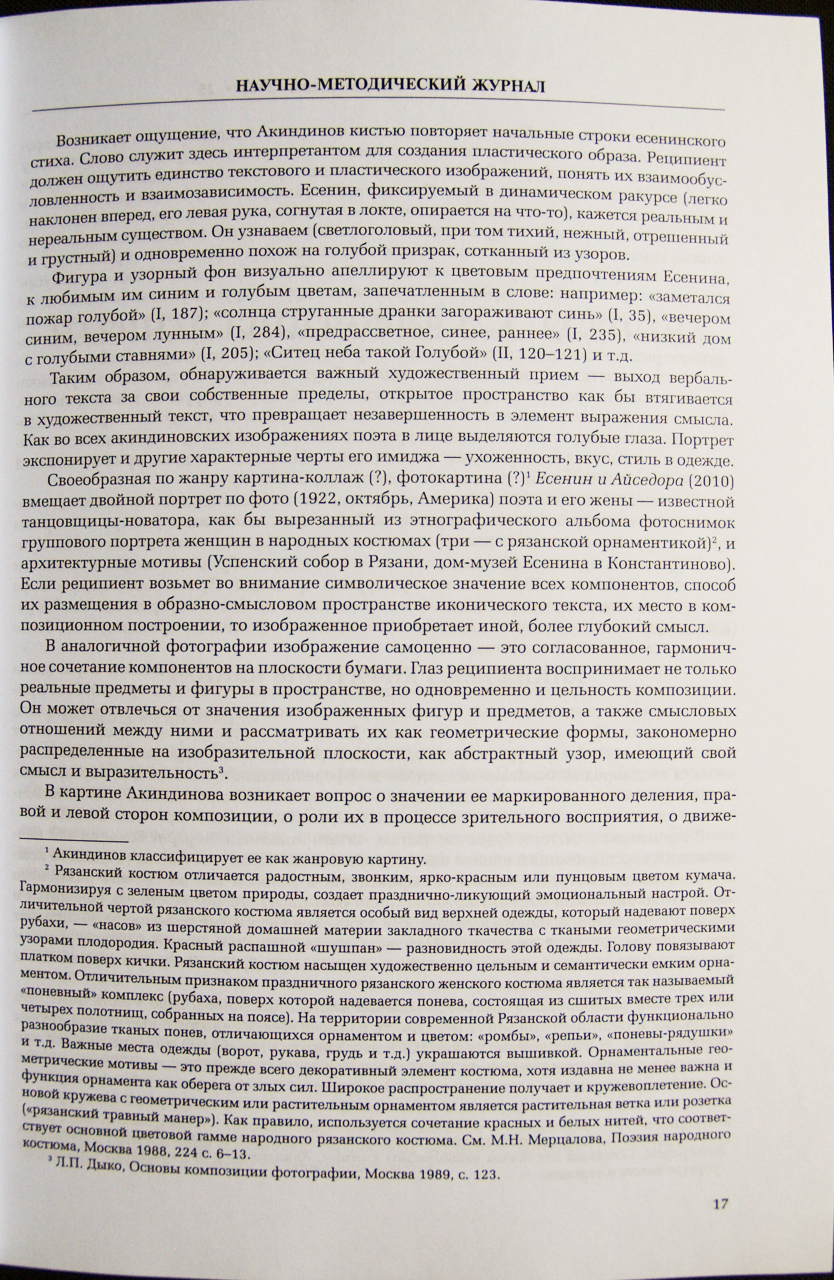
17th page of the «Modern Eseninovedeniye» magazine. No. 25. 2013. Ryazan.
There is a feeling that Akindinov a brush repeats initial lines of an eseninsky verse. The word serves here as an interpretant for creation of a plastic image. The recipient has to feel unity of text and plastic images, understand their interconditionality and interdependence. Yesenin fixed in a dynamic foreshortening (it is easily inclined forward, his left hand bent in an elbow, leans on something), seems a real and unreal being. It is recognizable (fair-haired, thus silent, gentle, released and sad) and at the same time blue ghost weaved from patterns. The figure and patten background visually appeal to Yesenin's color preferences, to the loved it blue and blue flowers imprinted in the word: for example: "the fire blue" (I, 187) was swept up; "the sun struganny shingles block a blue" (I, 35), "in the evening blue, in the evening lunar" (I, 284), "pre-dawn, blue, early" (I, 235), "the low house with a blue sun blind" (I, 205); "Chintz of the sky such Blue" (II, 120-121), etc. Thus, the important artistic touch – a release of the verbal text out of the own limits is found, the open space is as though involved in the art text that turns incompleteness into an element of expression of sense. As in all akindinovsky images of the poet in the person blue eyes are allocated. The portrait exhibits also other characteristic features of its image – an grooming, taste, style at clothes.
A peculiar picture collage on a genre? photopicture? * (26) "Yesenin and Isadora " (2010) contains a double portrait on a photo (1922, October, America) the poet and his wife – the known dancer innovator, the picture of a group portrait of women as though cut-out from an ethnographic album in national suits (three – with the Ryazan twiddle) * (27), and architectural motives (the Uspensky cathedral in Ryazan, Yesenin's house museum in Konstantinovo).

"Yesenin and Isadora." 80.5x110.5sm, oil on canvas. 2010. Alexey Akindinov.
If the recipient takes in attention symbolical value of all components, a way of their placement in figurative and semantic space of the ikonichesky text, their place in composite construction, represented gets other, deeper meaning. In a similar photo image of self-worth - is consistent, harmonious combination of components on the paper plane. The eye of the recipient perceives not only real subjects and figures in space, but at the same time and integrity of composition. It can distract from value of the represented figures and subjects, and also the semantic relations between them and to consider them as the geometrical forms which have been naturally distributed on the graphic plane, as the abstract pattern making the sense and expressiveness * (28). In Akindinov's picture there is a question of value of its marked division, the right and left parties of composition, about their role in the course of visual perception, about movement from left to right as designation of temporary sequence.
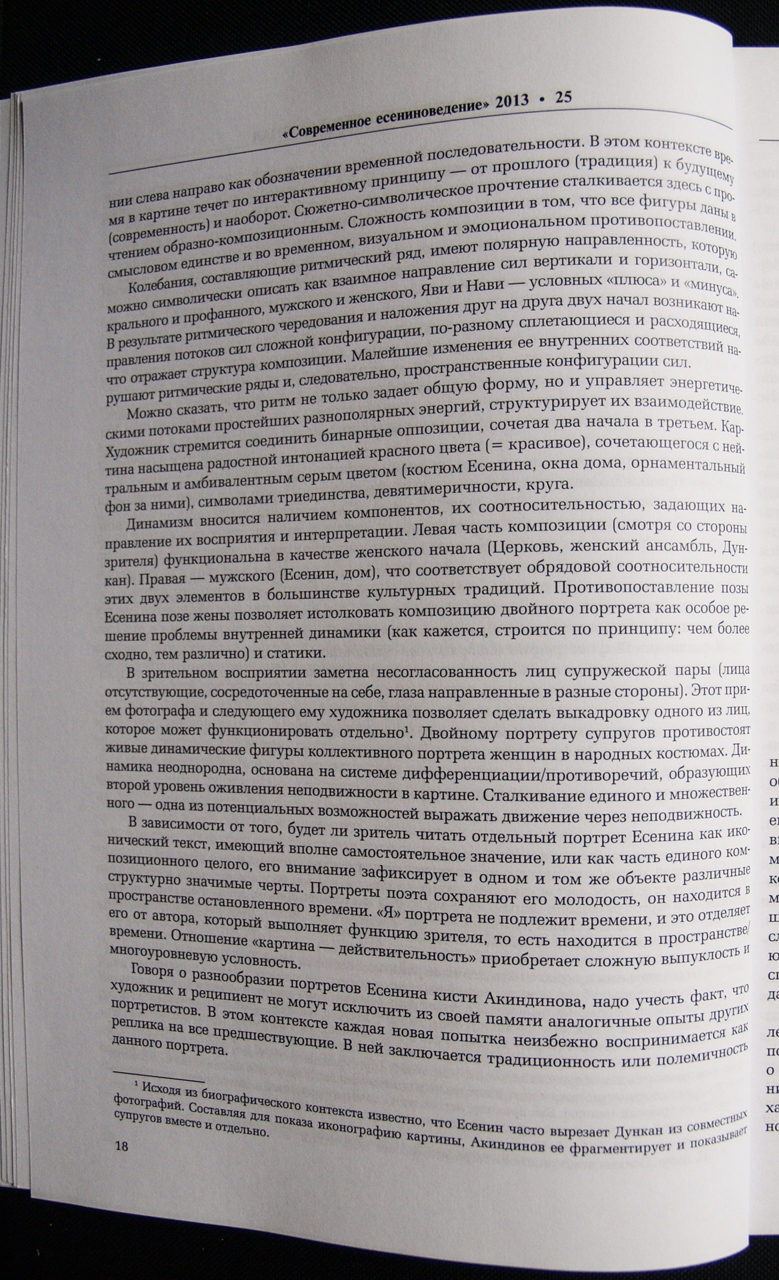
18th page of the «Modern Eseninovedeniye» magazine. No. 25. 2013 Ryazan.
In this context time in a picture passes by the interactive principle – of the past (tradition) to the future (present) and on a turn. Subject and symbolical reading faces here reading figurative and composite. Complexity of composition that all figures are given in semantic unity and in temporary, visual and emotional opposition. The fluctuations making a rhythmic row, have a polar focus which can be described symbolically as the mutual direction of forces of a vertical and a horizontal, sacral and profanny, man's and female, the Reality and Navi – conditional "plus" and "minus". As a result of rhythmic alternation and imposing at each other two beginnings there are directions of streams of forces of the difficult configuration, differently being weaved and dispersing that the composition structure reflects. The slightest changes of its internal compliances break rhythmic ranks and, therefore, spatial configurations of forces. It is possible to tell that the rhythm not only sets the general form, but also operates power streams of the elementary heteropolar energiya, structures their interaction. The artist seeks to connect binary oppositions, combining two beginnings in the third. The picture is saturated with joyful intonation of red color (= beautiful), being combined with neutral and ambivalent gray color (Yesenin's suit, house windows, an ornamental background behind them), symbols of trinity, a devyatimerichnost, a circle. Dynamism is brought by existence of components, their sootnositelnost, setting the direction of their perception and interpretation. The left part of composition (taking a detached view the viewer) is functional as a feminine (Church, female ensemble, Duncan). The right – man's (Yesenin, the house) that corresponds to a ceremonial sootnositelnost of these two elements in the majority of cultural traditions. Opposition of a pose of Yesenin to a pose of the wife allows to interpret composition of a double portrait as a singular solution of a problem of internal dynamics (as it seems, is under construction by the principle: the is more similar, the variously) and statics. In visual perception inconsistency of persons of a married couple (the person absent, concentrated on itself, eyes directed in different directions) is noticeable. This reception of the photographer, and the artist following it, allows on allocation of one of persons * (29). The double portrait of spouses is resisted by live dynamic figures of a collective portrait of women in national suits. Dynamics is non-uniform, based on system of the differentiations/contradictions forming the second level of revival of an immovability in a picture. Colliding uniform and multiple – one of potential opportunities to express movement through an immovability.
Depending on, whether the viewer will read Yesenin's separate portrait as the ikonichesky text having quite independent value or as part uniform composite whole, its attention will record various structurally significant lines in the same object. Portraits of the poet keep his youth, he is in space of stopped time. "I" a portrait am not subject to time, and it separates it from the author who carries out function of the viewer, that is is in space/time. The relation "a picture – reality" gains difficult camber and multilevel convention. Speaking about a variety of portraits of Yesenin of a brush of Akindinov, it is necessary to consider the fact that the artist and the recipient can't exclude similar experiences of other portraitists from the memory. In this context each new attempt is inevitably perceived as a remark on everything previous. Traditional character or polemichnost of this portrait consists in it.
NOTES:
(1). I.E.Danilov, the Word and a visible image in the European painting from the Middle Ages before the XX century, Moscow 2002, page 54.
(2). R. Bart, Myth today. The myth as the statement//the Chosen works: Semiotics. Poetics. Translation from French. originator. public editor and Kosikov's introduction, Moscow 1989, page 73.
(3). I.E.Danilov, the Word and a visible image in the European painting... page 55.
(4). N. Shubnikova-Gusev, Yesenin as theorist of art. To question statement, http://independent-academy.net/science/tetradi/14/shubnikova.html
(5). Kiselyov's L.A, Dialogue of Old Russian and symbolist concepts of the word in eseninsky "Maria's Keys"//Пам’ять майбутнього: Збiрник наукових праць, вип. 1, Київ 2001, page 66-82.
(6). S. Yesenin, Complete works in seven volumes. Hl. edition of Yu.L.Prokushev, IMLI of A.M. Gorky Russian Academy of Sciences, t. V, Moscow 1995-2002, page 186; electronic publication: FEB, http://feb-web.ru/feb/esenin/default.asp?/feb/esenin/texts/es0.html. Let's use further the above edition, designating in brackets volume and the page.
(7). A.P.Akindinov, Official site of the artist, http://www.akindinov.com; A.Akindinov "Pattern of sacred signs", Science and Religion magazine 2003, No. 6, page 39. Warmly I thank Alexey Akindinov for opportunity to use his site and an iconography.
(8). Citation for: Kiselyov's L.A, Dialogue of Old Russian and symbolist concepts of the word... page 66-82.
(9). Concept "moire" (fr. moire) occurs from fabric moire at which finishing the moire pattern arising at imposing of two periodic mesh drawings is used. Their repeating elements follow with a little different frequency, being imposed at each other and/or forming intervals. See. Wikipedia, http://ru.wikipedia.org/wiki/Муаровый_узор
(10). Word meaning "bear-hunter (safecracker)" according to the dictionary T.F.Efremova's online: colloquial bear hunter; the dog accustomed to hunting for a bear; ustar. the leader of the trained bear; the room for bears in a zoo; burglar of safes, http://slovonline.ru/slovar_efremova/b-13/id-44332/medvezhatnik.html.
Taken out in the title of a picture of Akindinov the word "bear-hunter (safecracker)", can function only as "burglar", but in figurative sense, i.e. the one who opens/opens/unlocks something. Some consider that in the name of a picture there is the hidden sense having something in common with essence of Russia. See: G. P. Ivanova, He "turned eyes pupils in soul": http://esenin.ru/zhivopis/akindinov-a-p.html
(11). The first option of the picture (2000) of the same name is sustained in other flowers.
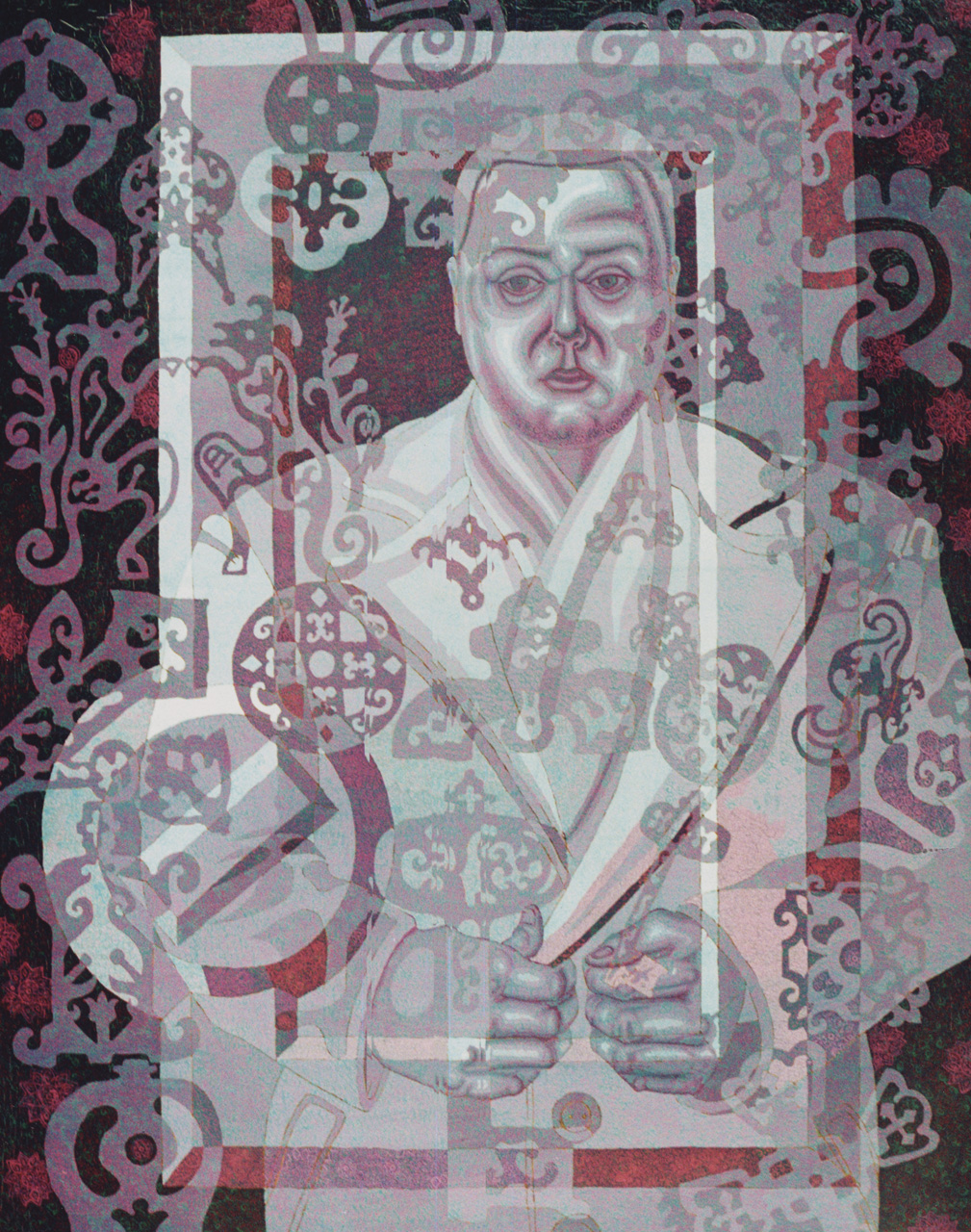
"Safecracker". 64x52sm, oil on canvas. 2000. Alexey Akindinov.
Dominated by purple- violet tone , background - black, red brushstrokes , the figure of the character easily razbelennye . The overall flavor, causing a sad, romantic mood , imposed semantics of colors that can be associated , for example, the spiritual principle , introspection , mystery , intuition, individuality, spirituality , hidden opportunities , spiritual power.(12). The key is a composite center , semantically meaningful and far-reaching substantive element in conceptualized in principle figurative symbolism (" objective art" ) , entitled "Discovery" (2001).

"Discovery". 63.5x57.5sm, oil on canvas. 2001. Alexey Akindinov.
In a kind of synthesis of objects , characters ( lock doors , fragments of the necropolis ) and surroundings (landscape, dog , water), compiled on the principle of contrast (live - dead ) and the compound , the key is encoded by three ideograms universal values . The graphic symbol of cross in a circle in the genesis of his deity represents the ratio between the earth and the sky. It is a symbol of the sun , the annual cycle , union of the male and female principles , unity and triad , the symbol of life and the creative process. Semantically comprehensive and ideogram star and three triangles around the circle . Symbolism of the dog is determined mythological context , it connects the living and the dead worlds , guarding the border between them.
(13). A.P. Akindinov, official website of the artist, http://www.akindinov.com
(14). Yesenin, Dove of Jordan, http://feb-web.ru/feb/esenin/texts/es2/es2-057-.htm
(15). I.E. Daniel, The problem of genres in European painting. The person and the thing. Portrait and Still Life, Moscow, 1998, p. 9.
(16). Y.M. Lotman, On the Art, Moscow 1998, p. 500-518.
(17). Akindinov claims that his very first paintings ( painted in oil on leatherette ) are : a copy of a painting by Vasily Polenov reproduction of the Moscow court and portrait Esenina. Artist Captures the image of the poet in the word , in a kind of sculpture- toy form. Translating verbal text into a visual artist composes verbal and pictorial thumbnail - Sunset pipe factory and Yesenin (cycle Small prose , the story number 42), in which the real world in harmony with the world of children's games . Expressiveness of speech , creating a parallel series of iconic , dynamized maintain the integrity and revitalizes Esenina toy : " The road leading to the south- west. Sun licked factory chimneys and the horizon . Pipes are transparent and green, they are intertwined, as tangled ball of yarn . The road to it - it's a long striped polovichek red. On both sides of the tracks are plywood and plastic trees are green soldiers of the Soviet Army . Sun shoots into the night sky bright gold and copper rays , they are straight , though Drawn on the airfield. Sculpture toy Esenina sad , but despite her sadness and greens , she goes on velvet red doormat , constantly keeping the sunset view point . " http://www.akindinov.com/russian/shortstories2.htm
(18). Y.M. Lotman, Portrait / / Articles Semiotics of Culture and Arts, St. Petersburg 2002, p. 349-375, electronic version, http://philologos.narod.ru/lotman/portrait.htm
(19). Y.M. Lotman, Portrait ..., http://philologos.narod.ru/lotman/portrait.htm
(20). V.I. Mikhalkovich, V.T. Stigneev, Poetics of Photography, Moscow 1989, p. 151.
(21). Image of a man walking on the background of nature (or architecture) appears in England in the XVIII century. It is especially popular in the era of sentimentality.
(22). Akindinov's belief that visual language of his pictures translated to word language, and the viewer reincarnating in the reader can perceive and read at the same time his painting as the prosaic or poetic text, is realized in practice. His friend and the coauthor of joint art projects Willie (Vitaly) Melnikov – the poet polyglot, the founder innovative, author's art genres of poetry (lingvogobelen, lyumenoskript, a drakonografiya) and poetic styles – muftolingva, intraksenolingva (see: Grazhina Bobilevich, Art-poezo-zhanry as an intermedialny discourse//literature Visualization, Belgrad 2012, page 245-264) will try to translate and decipher some pictures of the artist by means of languages known to it. So “Morning Esenin” and “Patterns of evening visits” (1998 ) presented Melnikov "diptych , the talk about how the tradition of legend and the current daily exchange dialects of its colors , revealing each other relatives. Both pictures I saw the embroidery wrapped in verbal languages: Tlingit (one of the Indian peoples of Canada ) , Rapa Nui ( Easter Island ) , uavniffa (West Africa), Faroe Islands ( Scandinavia) , phadme (Manchuria ) . If < go > deep in both landscape meander along a diagonal line from the bottom up , he found himself in the rapids of the free verse : < Cora Verge , Fallen from the trunk neprolozhennoy road, looking for key core to unlock hardcover book roots to the crown, had long wished to write there heads of their leaves before they fall off twilight- coral ...> ". (V.Melnikov, Poezo-zhivopis Alexey Akindinov//Alexey Akindinov. Painting. The catalog, Ryazan 2008, on site www.akindinov.com materials). "Morning of Yesenin” (languages: aria, Orkhon, Tangut, cholanayken): canvases, autumn flown from stretchers is a core of views of them from labyrinths of flowers dialects of the shades, tired to give out itself for bark of dumbness of dabs of paints". (Willie R. Melnikov, Prochteniye-meditantsy of canvases Alexey Akindinov. From the Second Approach exhibition 11. 09 . 2008, http://www.akindinov.com/reviewru/176-reviewru6
(23). The term has conditional character and in this case means special integrity and completeness of a portrait of Yesenin. Its essence is opened by composite decisions and all separate elements subordinated to subject action which is based on binary opposition life – death.
(24). To a picture Akindinov writes to autocomments: "My picture Death Dance is a creative link in development of a subject so-called <death dancings> in the world art, especially inherent in the West European medieval art. But in difference from these works, I on the solved this composition. Having applied subjective vision of the world, through a prism me the created style – an ornamentalizm. Which essence consists in reality alloyage with an ornamentalnost. That is creation of new, ornamental reality. In a picture I represented the multifigured composition united by a certain action. Which is presented in the origin – start, the culmination – deification, and the ending – the finish which is at the same time and the new beginning, unknown for <mere mortal>. […] In a choice of the characters for a picture and their placement on a cloth I was guided by the principle of that the death is the ending of each person, probably, as a transitional link. […] Therefore I represented among the characters dancing at a fire of representatives; policy and revolutions – Lenin, poetry – Sergey Yesenin, science – Sergey Korolev, a vocal and music – Farukh Bulsar (Freddie Mercury), pioneers of space – Yury Gagarin, actresses – Merelin Monro (from a back). […] The small patterns covering all surface of a picture bear in themselves force and life symbolics. […] From small ornaments patterns having a grapheme of asterisks and beams (mainly in the sky) symbolize a firmament, the Sun and live energy of light. Patterns herbs having a grapheme and leaflets (mainly on the earth) symbolize juice of the vital forces necessary for revival and updating. The roundish patterns put generally on figures of people, symbolize themselves roots it is communication with our ancestors and their philosophical experience". The full text see: http://artnow.ru/ru/gallery/3/806/picture/0/237750.html
(25). Yu.M.Lotman, Portrait... http://philologos.narod.ru/lotman/portrait.htm
(26). Akindinov classifies it as a conversation.
(27). The Ryazan suit differs joyful, ringing, bright red or crimson color of a red bunting. Harmonizing with green color of the nature, creates festive an exulting emotional spirit. Distinctive feature of the Ryazan suit is the special type of outer clothing which put on over a shirt, – "noses" from a woolen house matter of mortgage weaving with woven geometrical patterns of fertility. Red oar "shushpan" – a version of these clothes. The head tie a scarf over a kichka. The Ryazan suit is saturated with artly integral and semantic capacious ornament. Distinctive sign of a festive Ryazan female suit is the so-called "ponevny" complex (a shirt over which it is put on poneva, consisting of the sewed together three or four panels collected on a belt). In the territory of the modern Ryazan region a variety woven is functional having understood, differing an ornament and color: "rhombuses", "bur", "ponevy-ryadushka", etc. Important places of clothes (gate, sleeves, a breast, etc.) are decorated with an embroidery. Ornamental geometrical motives it first of all a decorative element of a suit though ornament function as оберега from evil forces is long since not less important also. The wide circulation is gained also by a lace. Lace basis with a geometrical or vegetable ornament is the vegetable branch or the socket ("Ryazan travny manners"). As a rule the combination of red and white threads that corresponds to the main color scale of a national Ryazan suit is used. See M. N. Mertsalov, Poetry of a national suit, Moscow 1988, 224 pages 6-13.
(28). L.P.Dyko, Bases of composition of the photo, Moscow 1989, page 123.
(29). Considering a biographic context it is known that Yesenin often cuts out Duncan from joint photos. Making for display a picture iconography, Akindinov fragments it and shows spouses together and separately.
